1947 Maserati A6GCS Monofaro (Modena, 1947 - WINNER): The year 1947 was a watershed one for the Maserati company. The company which had been sold to the Orsi family a decade earlier introduced the A6 road sports car at the Geneva Motor Show in 1947. That car under the supervision of Alberto Massimino, head of development, would be the basis of Maserarti sports and race cars well into the 1950s. Up until 1947, the Maserati brothers had been responsible for racing car development and motorsport operations, but would leave to form O.S.C.A.
Model by LEO/IXO 1/43 |
1947 Maserati A6GCS Monofaro (Modena, 1947 - WINNER): Before they left the firm they created, the Maserati brothers along with chief mechanic Guerino Bertucchi had laid down the plans for a new open bodied sports car on a shortened A6 chassis. Utilizing a 2.0L, six-cylinder engine producing 125 HP, the cycle fendered race car would win its second outing at Modena in September, 1947, as Grand Prix driver Alberto Ascari drove to victory after 24 laps on the two mile (3.2 Km) track with his teammate Luigi Villoresi close behind in second.
Model by LEO/IXO 1/43 |
1947 Maserati A6GCS Monofaro (Modena, 1947): Luigi 'Gigi' Villoresi along with fellow Maserati team mate Alberto Ascari as typical of the period, drove sports cars in short and long distance events when not driving the factory grand prix cars. While firmly established as the team leader, Ascari usually had Villoresi in his rear view mirror as he did at the Circuito di Alberto race at Modena as part of the Italian Sports Prototype Championship in late 1947. Villoresi finished second to Ascari in this car, just a few seconds behind the winner and bot a lap ahead of the third place Alfa Romeo.
Model by LEO/IXO 1/43 |
1947 Maserati A6GCS Monofaro (Modena, 1947): The A6GCS received its Monofaro nickname from the single headlamp mounted in the center of the grille. The "A" stood for Alfieri Maserati, "6" for the number of engine cylinders, "G" for Ghisa (iron), "C" for Corsa (race) and "S" for sport. A total of 16 of these cars were built with Maserati racing them in 1947 and available to private teams from 1948-1950. The first cars like these received bodies designed and made by Modaro and Gino Fantuzzi's firm Carrozzeria Fantuzzi, but took on different closed and open fender configurations and was raced at the Mille Miglia and Targa Florio.
Model by LEO/IXO 1/43 |
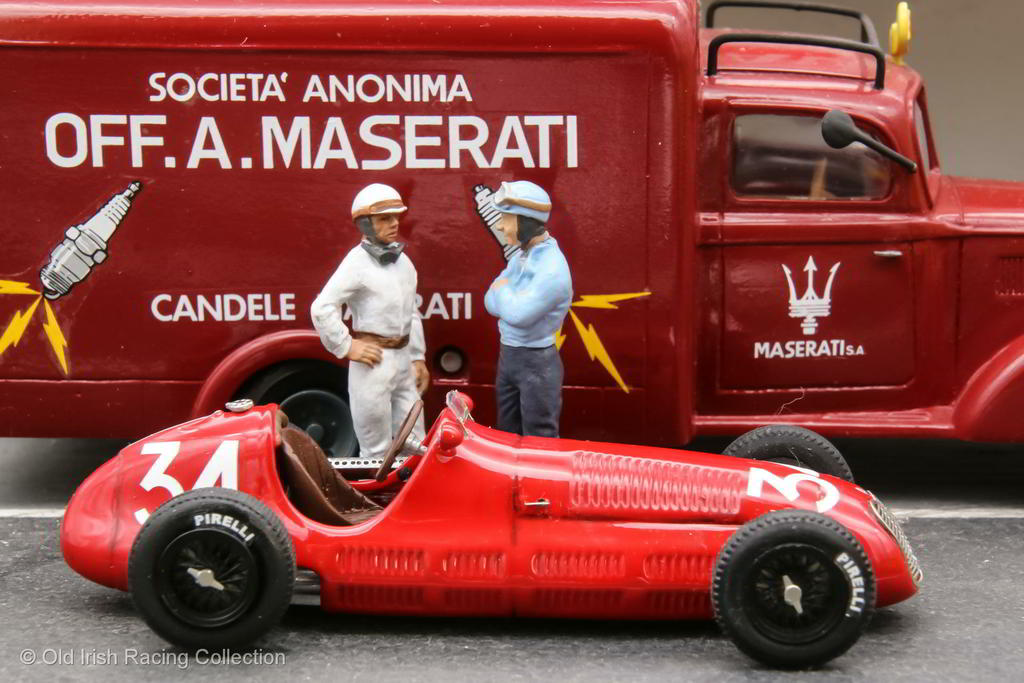 |
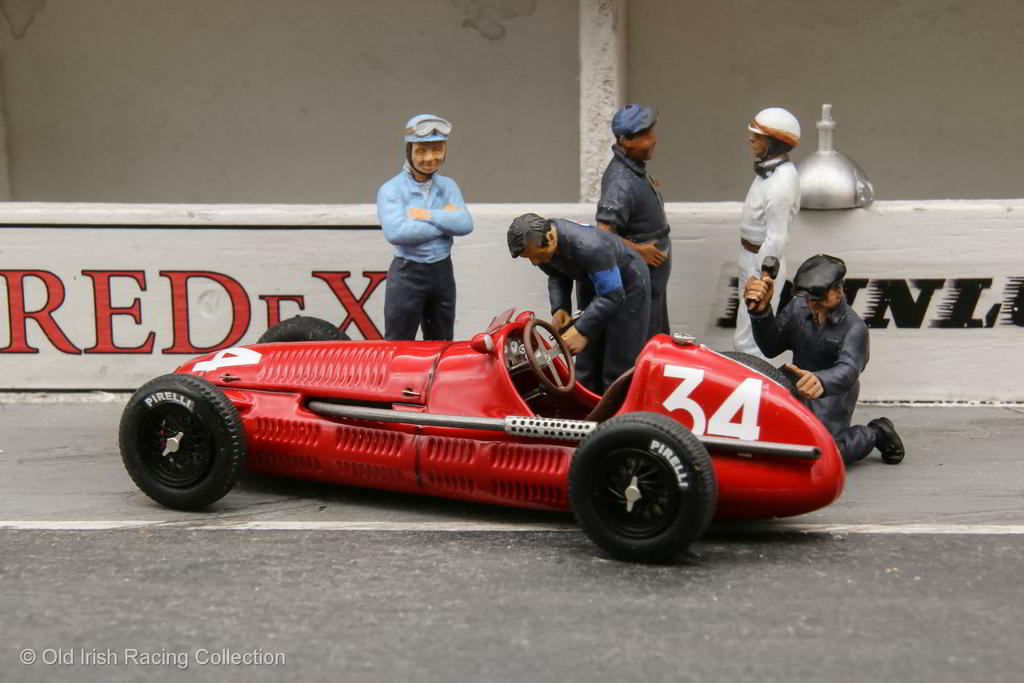 |
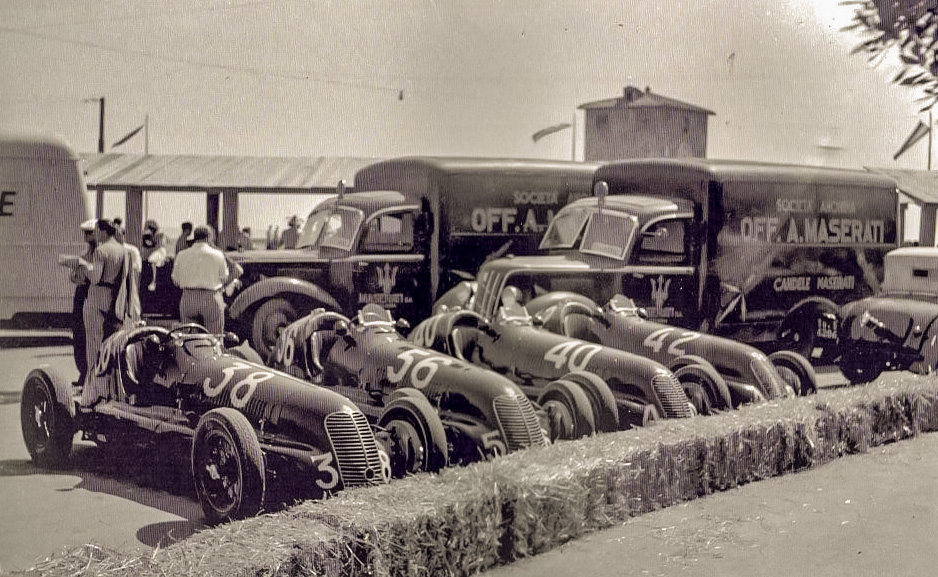 |
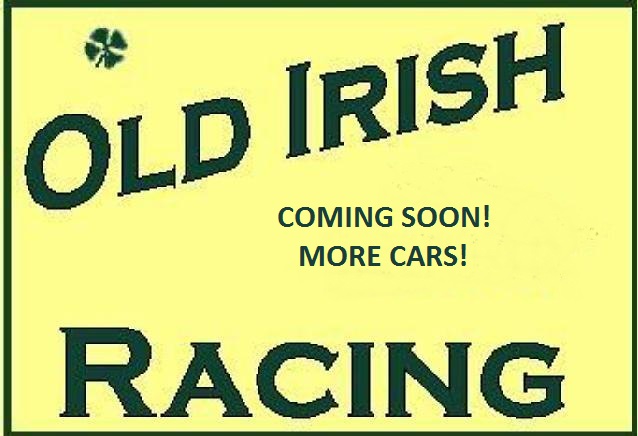 |
1948 Maserati 4CLT/49 Sanremo (San Remo GP, 1948 - WINNER): Maserati introduced the 4CL to voiturette racing in 1939. After WWII when racing resumed, Maserati, in the face of stiff competition, revised the 4CL to the supercharged 4CLT in 1948. Using the same 1.5L inline-4-clyinder engine of the older car, it was given an added supercharger which increased the power output to 260 BHP. Importantly, the car was given a tube chassis to increase the cars torsional rigidity with the new engine. It won its maiden race at the San Remo GP in 1948, from which it took its name.
Model by SMTS 1/43 |
1948 Maserati 4CLT/49 Sanremo (San Remo GP, 1948 - WINNER): Alberto Ascari drove this car to the first win for the new 4CLT in its first race. His good friend a teammate Luigi Villoressi finished second in another 4CLT, with an older $CL third in the non-championship race. The 4CLT would dominate voiturette racing in 1948, winning 13 of 23 GP races (Villoressi won six). Its most important win would be the FIA F1 race at Monaco, won by Farina. Maserati was the Manufacturers Cup winner in 1948 and despite a strong start in 1949, competition from Alfa and Ferrari caught up to end its GP domination.
Model by SMTS 1/43 |
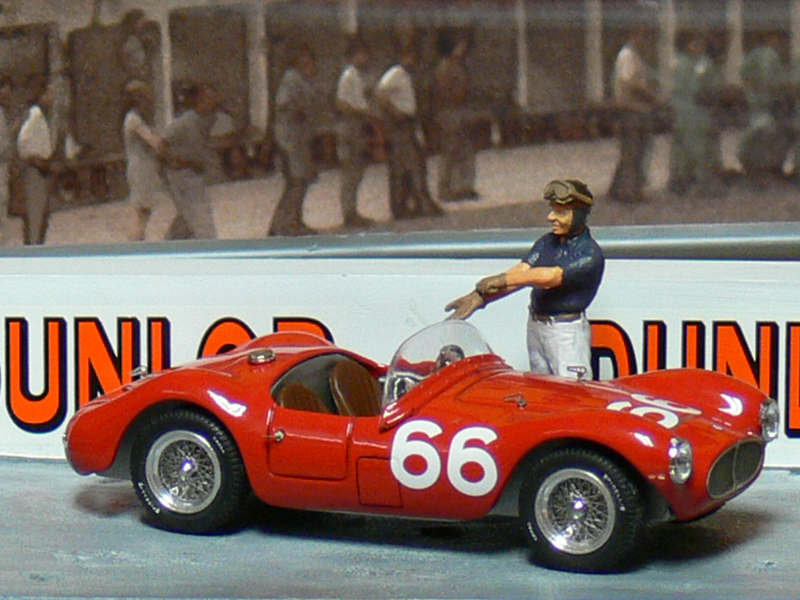 |
 |
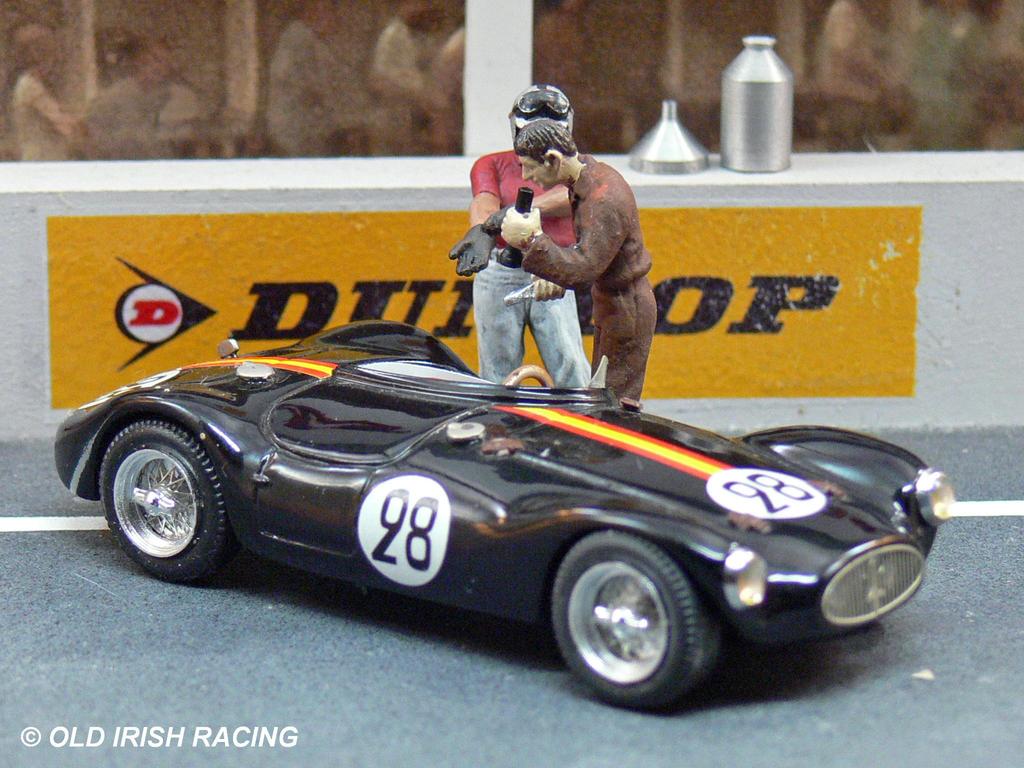 |
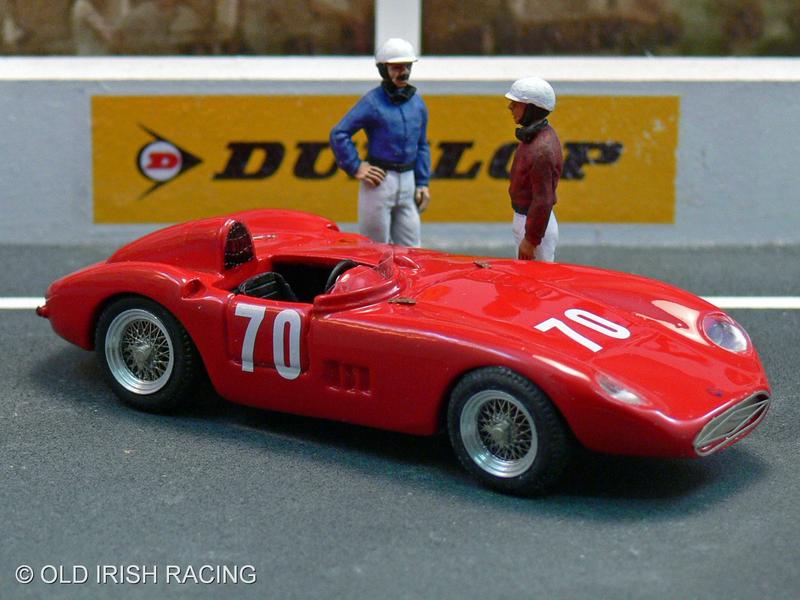 |
1953 Maserati A6GCS/53 (Targa Florio 1953): Designed to compete in the World Sportscar Championship, the A6GCS/53 (1953-55) designed by Columbo, was powered by a DOHC 2.0L straight-six, which developed 170 bhp. This was Maserati's first short-stroke engine, resulting in a stunning 7300 rpm red-line. Sergio Mantovani and Juan-Manuel Fangio drove this car to 3rd place at the '53 Targa Florio. The A6GCS/53 was conceived to provide a car for Maserati customers to enter and drive on the Mille Miglia and Targa Florio.
Model by BANG 1/43 |
1954 Maserati A6GCS/53 (Le Mans 1957): Frenchman Georges Guyot entered his Maserati at Le Mans in 1957. With co-driver Michel Parsy, the pair finished 12th overall and 3rd in class at that years 24 hour race. This was also the 1954 Paris Salon car. Georges entered cars for six Le Mans races, this his best finish. Fifty-two A6GCS/53 were made, with two of the greatest successes being wins at the Italian Grand Prix in 1953 and 1954 with Sergio Mantovani and Luigi Musso driving.
Model by M4 1/43 |
1954 Maserati A6GCS (Le Mans 1954): Marqués Alfonso de Portago and Carlo Tomasi drove de Portago's Maserati as a factory entry at Le Mans in 1954. This was the first Maserati to race at Le Mans. The factory entry did not arrive with the newest version of the A6GCS due to a transporter breakdown, so had to rely on de Portago's earlier car which he drove from Italy. The pair retired in the 11th hour due to a lack of engine oil pressure while contesting the class lead. They were classified at the finish as 32nd place.
Model by TOP MODEL 1/43 |
1955 Maserati 300S (Le Mans 1955): Entered by Maserati at the GP Supercortemaggiore at Monza in 1955, Roberto Mières and Cesare Perdisa drove to third place. Its sister car won the event with with Jean Behra and Luigi Musso driving. Musso drove this car at Le Mans in 1955 with Valenzano, but retired due to gearbox issues, aproblem which sidelined both team cars. The 300S has a 3.0L straigh-six, which puts out 245 hp. Twenty eight cars were produced between 1955-58.
Model by JOLLY MODEL 1/43 |
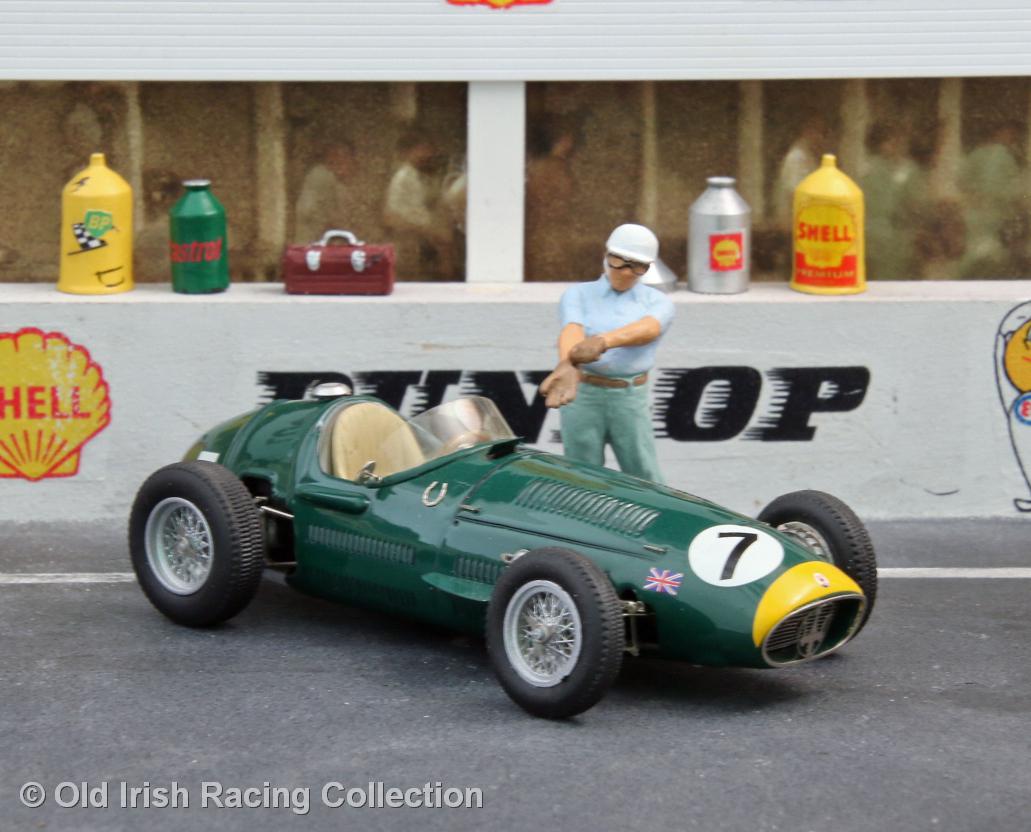 |
 |
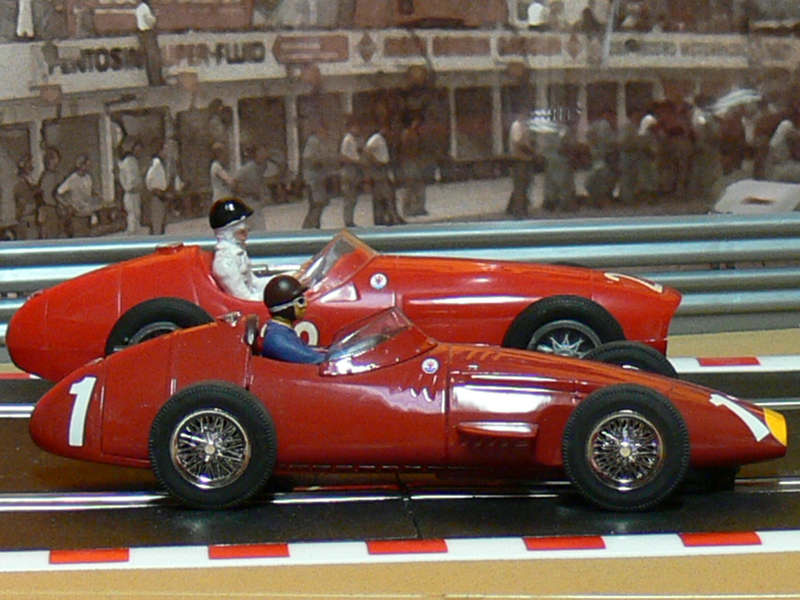 |
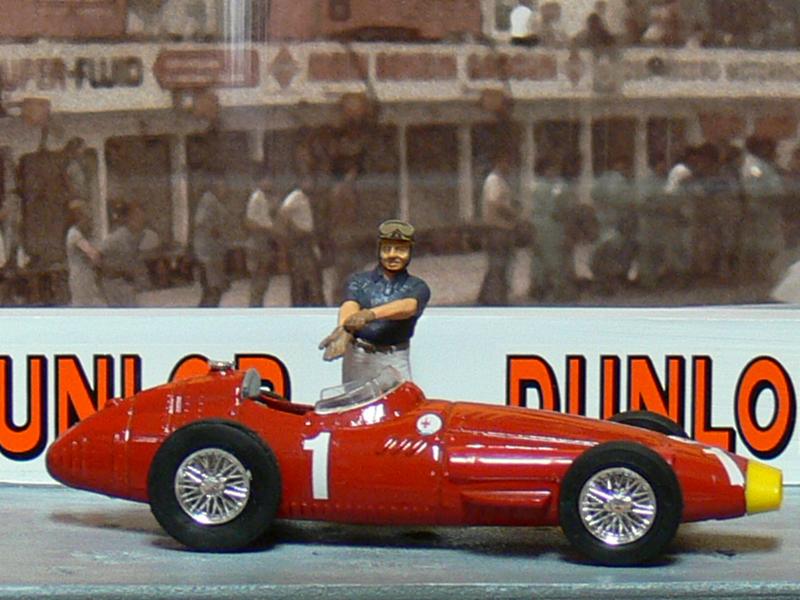 |
1954 Maserati 250F: One of the most beautiful F1 cars ever made, the Maserati 250F was introduced in 1954 and was made available to select customers, who competed alongside factory team cars. Stirling Moss owned this car and his small team run by his father Alfred developed disc brakes and fuel injection ahead of the factory team cars. At the Formula Libra race at Aintree in 1954, Moss dueled with Mike Hawthorn in a Vanwall; each setting fastest lap during the course of the race. Moss prevailed over Hawthorn who finished 2nd, with 250F's in 3rd and 4th places. Mercedes-Benz racing boss Alfred Neubauer had suggested that Moss buy the 250F to gain experience with a prospect of driving for Mercedes. Moss proved to be the equal of the Mercedes and Ferrari drivers in the 250F and of course ended up being signed by Mercedes for 1955. This is the livery of Moss' 250F at Aintree. The 2.5L straight-six Maserati ran on a brew of methanol, petrol, acetone, benzol and caster oil, with a surprisingly low 80 octane.
Model by RENAISSANCE 1/43 |
1955 Maserati 250F STR: For the fast, high banks of Monza, Maserati developed streamlined body work for the 250F. Driven by Jean Behra at the Italian GP to a 4th place finish, this body was only used once. For 1955, the 2.5L straight-six powered 250F was given a 5-speed gearbox and disc brakes. Behra was joined by Luigi Musso at Maserati for the '55 season, but the greatest success for the 250F was yet to come.
Model by LEO 1/43 |
1957 Maserati 250F: As he had done in 1954, the great Juan Manuel Fangio drove the 250F to his fifth World Championship in 1957. In this car, he was to finish 1st at the '57 German GP at the Nurburgring. He overcame a 50 second deficit in just 20 laps, passing the race leader on the final lap to take the win.
Model by SCALEXTRIC 1/32 |
1957 Maserati 250F (WORLD CHAMPION - 1957): Former Ferrari chief designer Gioacchino Colombo along with engineer Valerio Colotti were responsible for the chassis, suspension and transmission of the 250F, which debuted in 1954. For 1957, the 250F was powered by either a 2.5L 6 or 12-cyl. engine producing 270 bhp.
Model by BRUMM 1/43 |
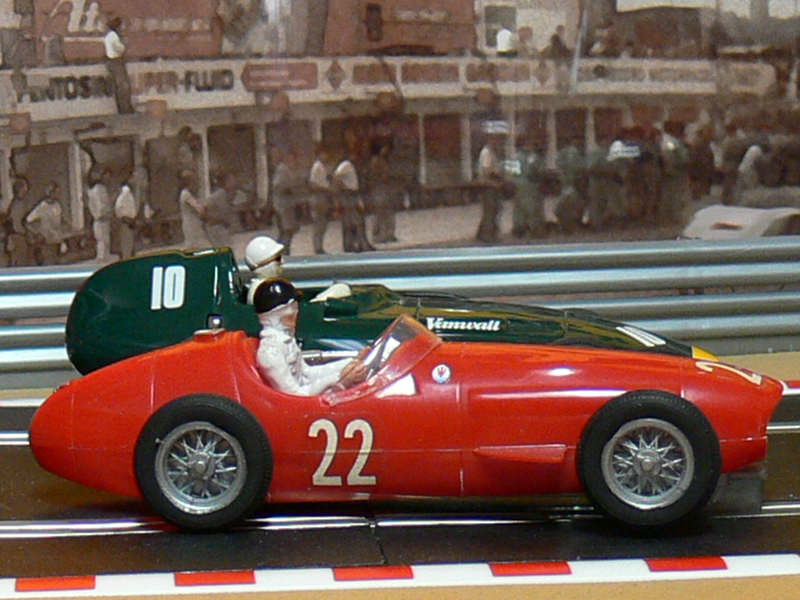 |
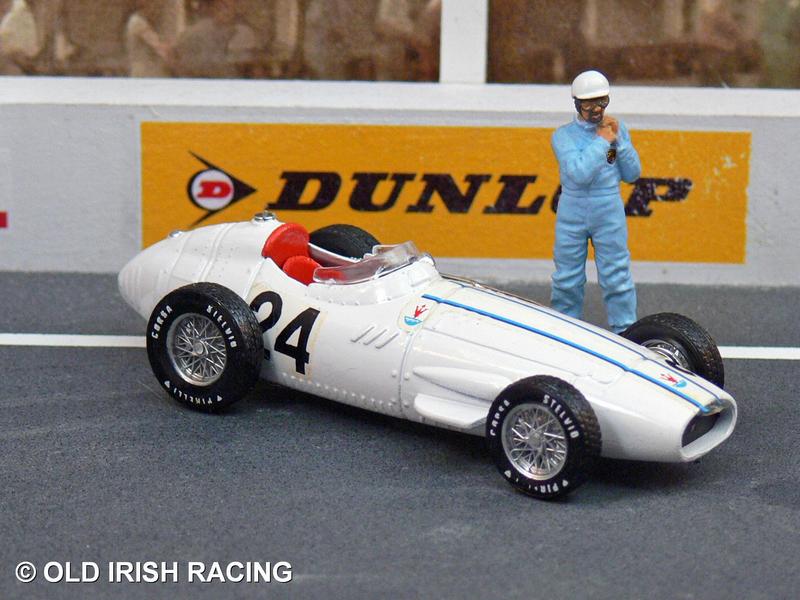 |
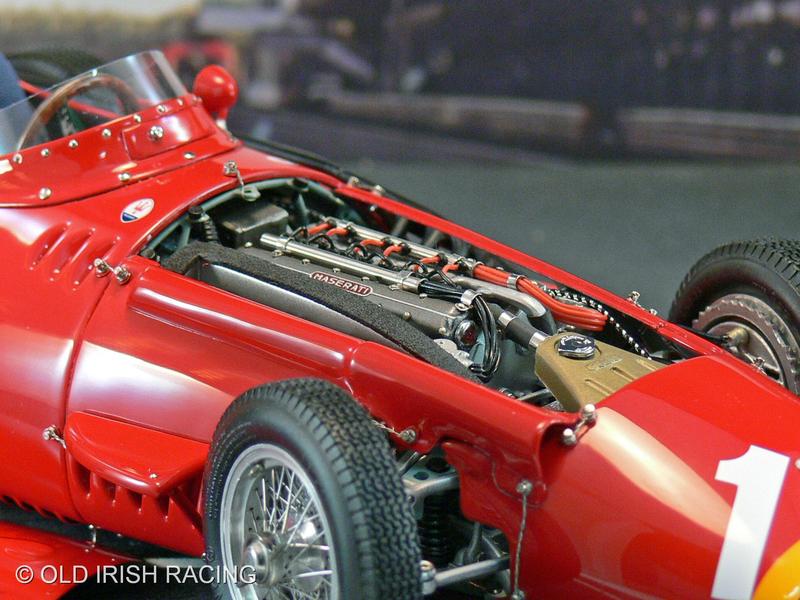 |
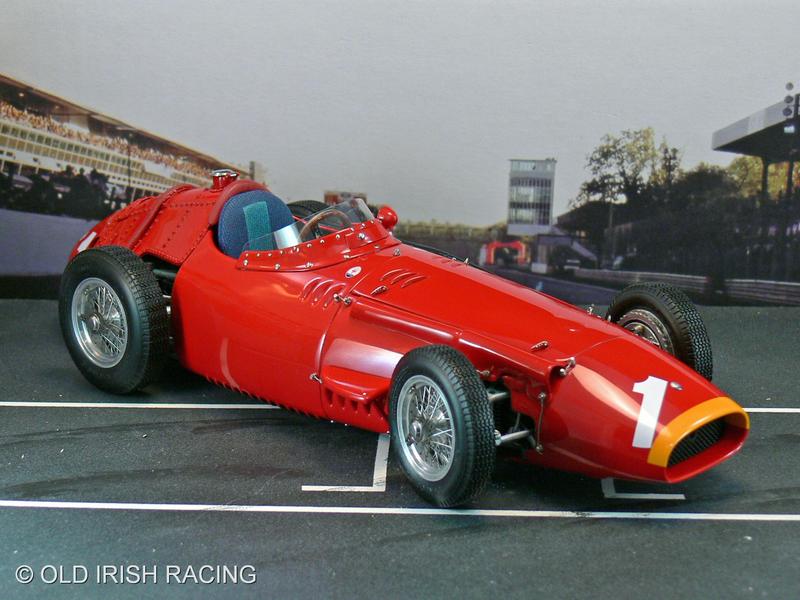 |
1957 Maserati 250F (57): Harry Schell drove to a 4th place finish at 1957 Argentina GP. 1957 would be the final year for Maserati as an entrant in F1, as the company went into receivership. The 250F however soldiered on in private hands in occasional appearances in F1 up until 1961.
Model by STROMBECKER 1/32 |
1957 Maserati 250F: Jo Bonnier drove this Scuderia Centro Sud entry to 7th place at the 1957 Argentina GP. Maserati behind the great Fangio finished 1-2-3-4 in that race, the first of the 1957 F1 season. Carroll Shelby also drove two races for the team in 1958.
Model by BRUMM 1/43 |
1957 Maserati 250F (WORLD CHAMPION) - 1957: Fangio's German GP winning car.
Model by CMC 1/18 |
1957 Maserati 250F (WORLD CHAMPION - 1957):
Model by CMC 1/18 |
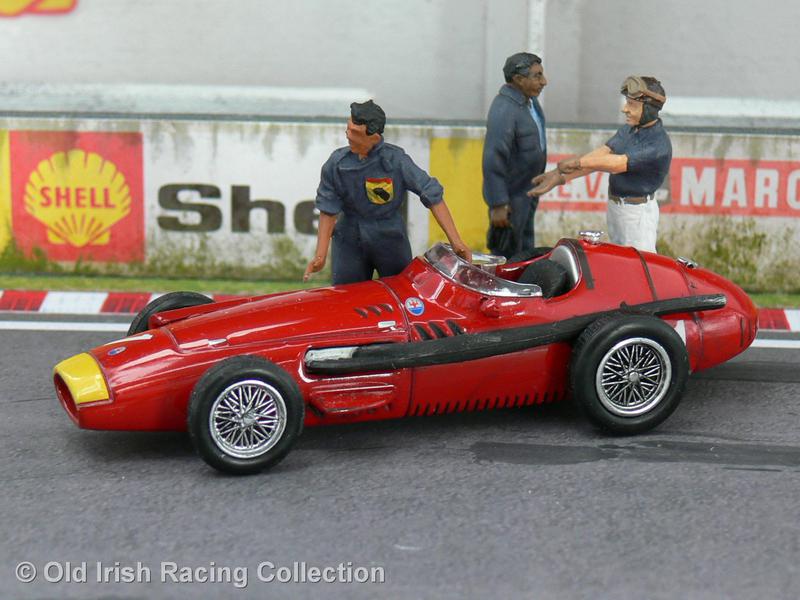 |
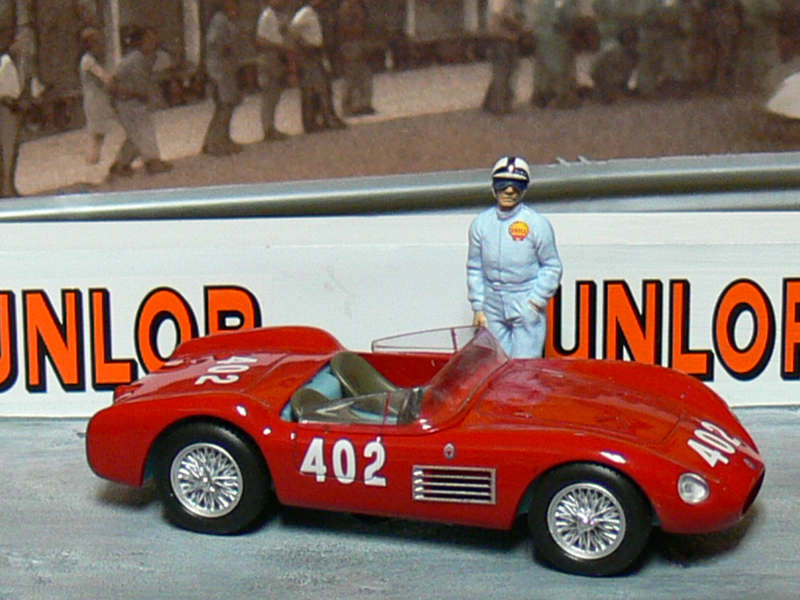 |
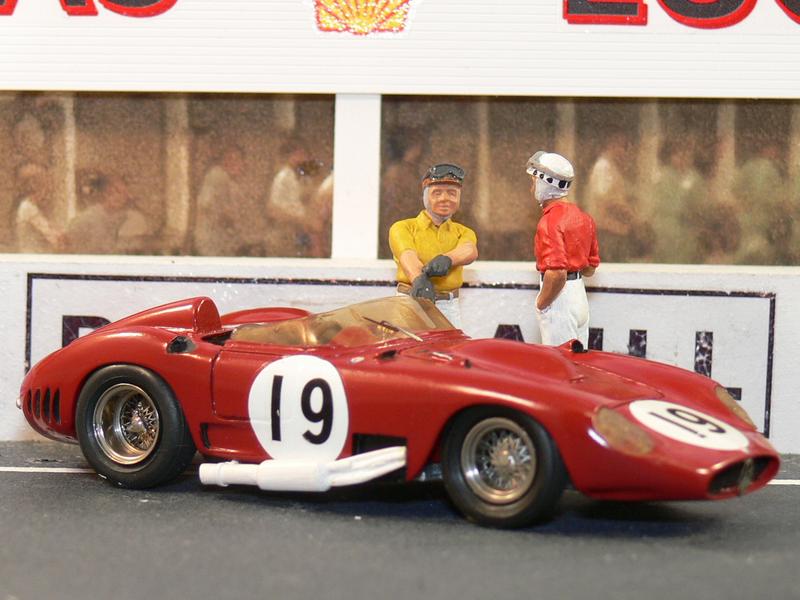 |
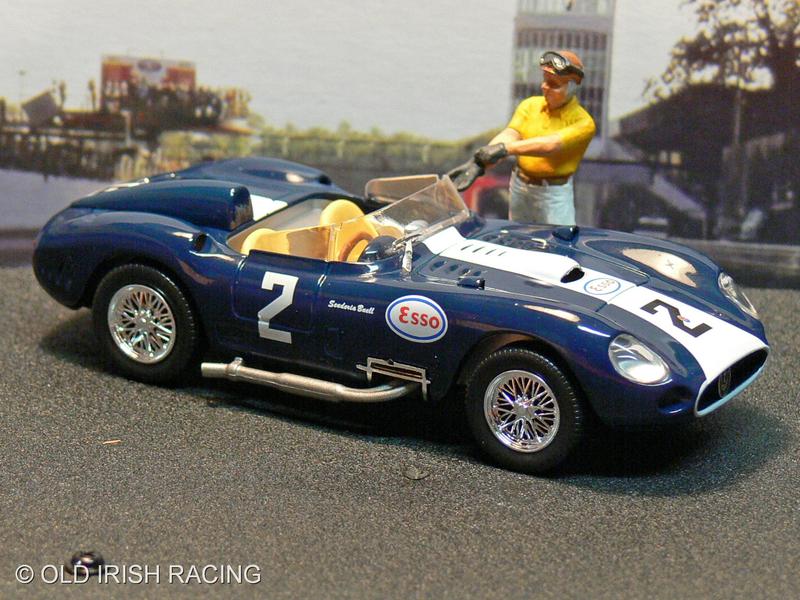 |
1957 Maserati 250F (WORLD CHAMPION - 1957): The fabulous maistro Juan Manuel Fangio and his 250F from 1957.
Model by SCHUCO 1/43 |
1957 Maserati 150S )Mille Miglia 1957): Michel Guy drove this 150S at the 1957 Mille Miglia, but failed to finish. Powered by a 1.5L dual overhead cam engine, the 150S produced a respectable 140 hp, and a top speed of over 140 mph. Produced as "client cars" the factory racing efforts centered around the 200S and 300S. I think this aluminum bodied, tube frame car is the best looking of them all.
Model by METRO 1/43 |
1957 Maserati 450S (SEBRING WINNER - 1957): The 450S was raced in the 1957 World Sports Car Championship, where it finished second to Ferrari in the champoinship. The 450S has a 4.5L V8, which produces 400 bhp. This car (Chassis #4503) is one of the nine 450S' built and Juan-Manuel Fangio and Jean Behra drove the car to victory at Sebring.
Model by AUTOMANY 1/43 |
1957 Maserati 450S (GP of Cuba 1958): In one of the most bizarre episodes in racing, Juan Maunuel Fangio who was to drive this car, was kidnapped prior to the 1958 GP of Cuba by Cuban rebels. Maurice Triginant drove the car in the race finishing 11th. The car (Chassis #4508) was later driven and then owned by Carroll Shelby, Jim Hall racing the car during Shelby's ownership.
Model by GRANINI 1/43 |
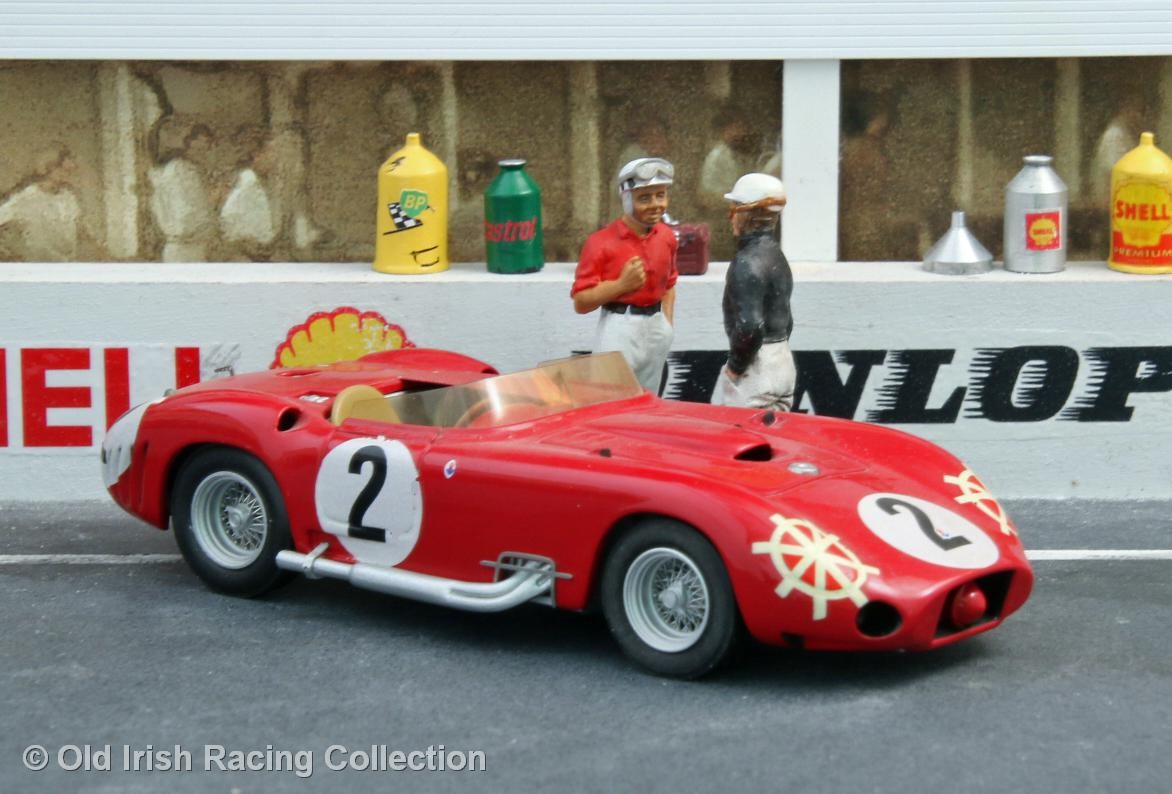 |
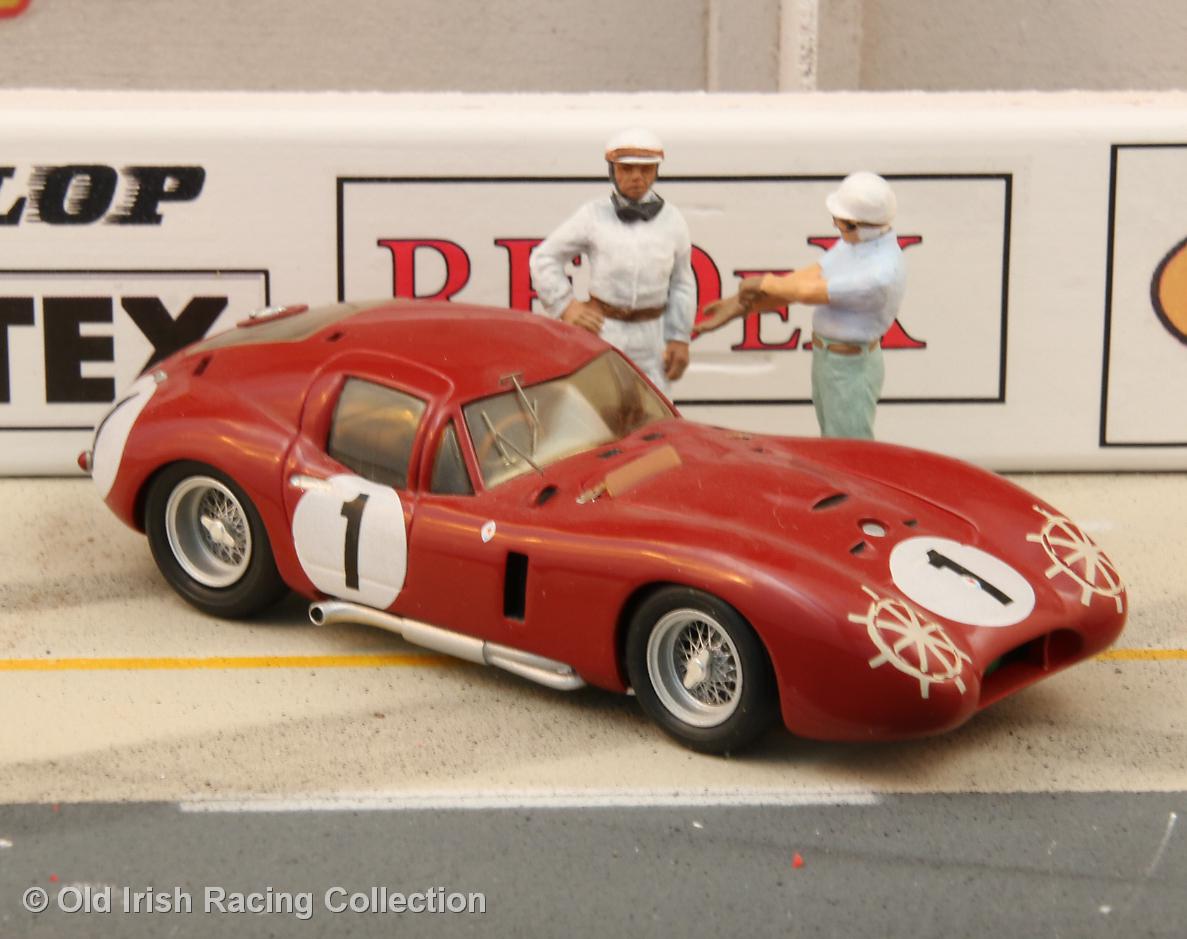 |
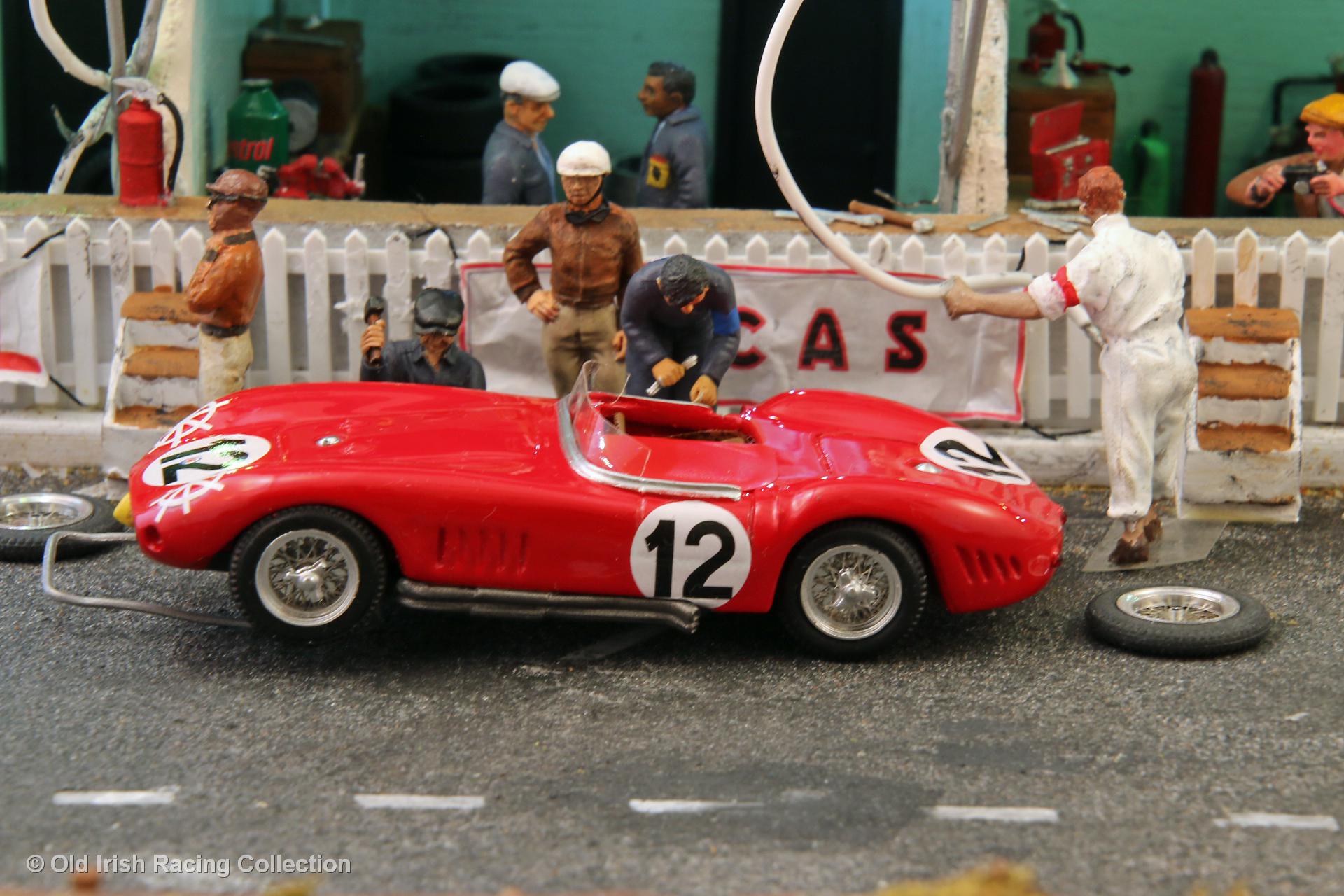 |
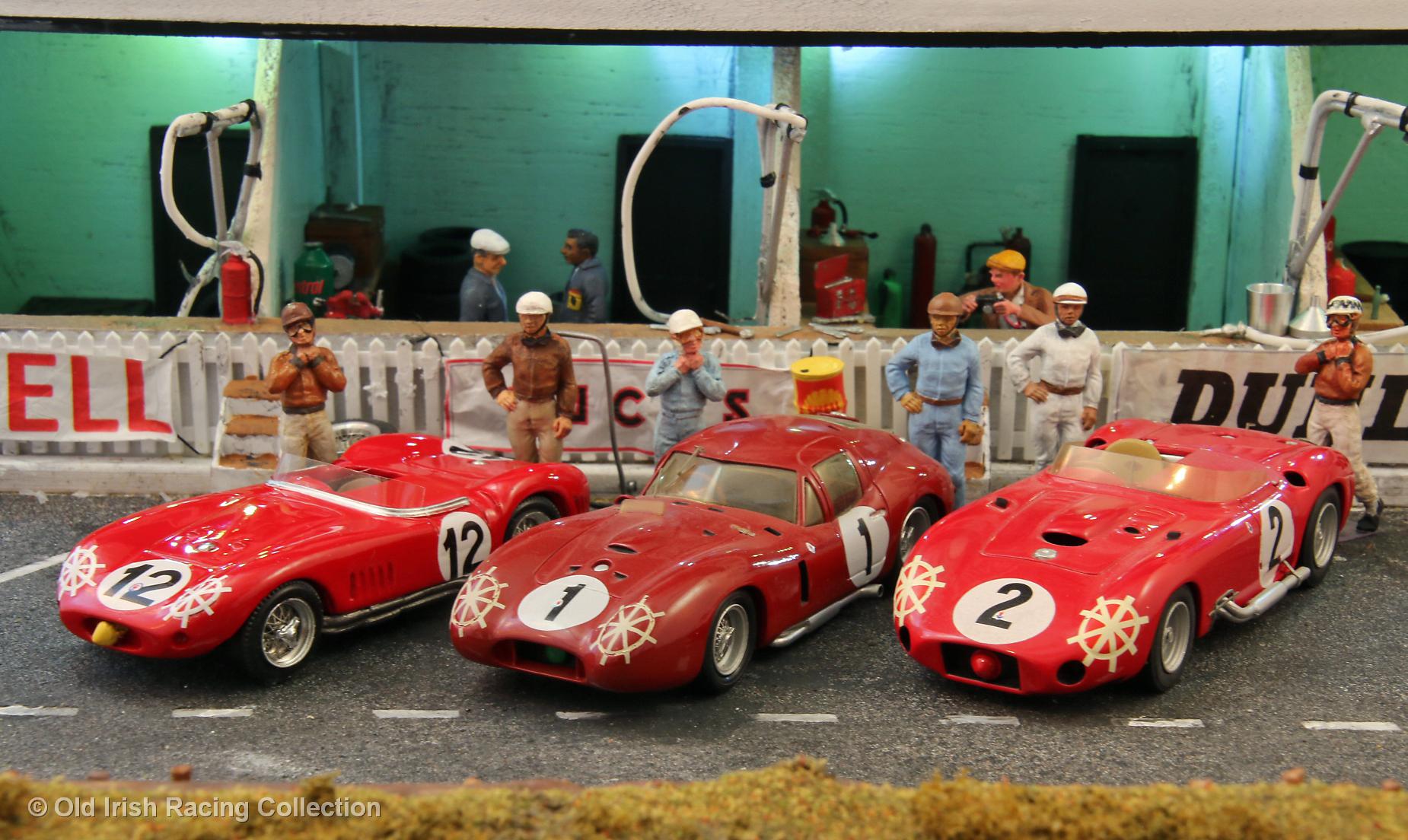 |
1957 Maserati 450S (Le Mans 1957): Jean Behra and Andre Simon drove this then new 4.5L quad-cam V8 engined 450S (Ch.#4503) at Le Mans in 1957, teamed with the 450S Coupe driven by Stirling Moss and Harry Schell. Juan Manuel Fangio was listed as the car's relief driver and set fastest time of all cars in practice. However, since Fangio did not like to drive in 24-hour events, he never drove. Not that he would have had the opportunity. After less than four hours into the race and 28 laps, the rear u-Joint went and the car was retired. The same fate befell its sister car and this would be the last Maserati factory entry at Le Mans. This is the same car the Behra drove with Fangio to the Sebring victory earlier in the season and won the GP of Sweden after Le Mans with Stirling Moss.
Model by AMR 1/43 |
1957 Maserati 450S Zagato Coupe (Le Mans 1957): Stirling Moss and Harry Schell drove one of Maserati's two entries at Le Mans in 1957. Maserati had employed Frank Costin to design a coupe body for the 4.5L V8 powered car. Zagato hastily built the body, altering Costin's original design. It was not as fast as the 450S spider version which Fangio has set fastest lap in practice. Originally designed by Frank Costin, Zagato changed much of his original design and rushed the job to completion. Without aid of testing, it turned out the coupe was claustrophobic and still being finished when unloaded in the Le Mans paddock, it threatened to pop out is windscreen during practice. Despite the talent behind the wheel, the car retired in the first hour with a broken transmission/U-Joint.
Model by NESTOR 1/43 |
1957 Maserati 300S (Le Mans 1957): Joining the two new 450S cars at Le Mans in 1957, Maserati entered a third car, this 300S in hopes of outright victory. Driven by Giorgio Scarlati and Jo Bonnier who was making his Le Mans debut, the duo had their car as high as 12th place before the clutch went on lap 73 in the 7th hour of the race. It was the last hope of a works car finishing the race on a disastrous weekend for Maserati. Maserati built twenty-six 300S cars between 1955 and 1958, with the majority going to customers, many to the USA where they were successful in club racing. Powered by a 3.0L straight-6 engine which produced 245hp, the engine of the 300S was based on that in the 250F F1 car. The aluminum bodied 300S also shared the open wheel car's suspension and brakes, but unlike the 250F, had a De Dion rear axle rather than a live axle. This car was used throughout the 1957 season by Maserati, including the Mille Miglia (4th) and Swedish GP (3rd) before being written off after Le Mans in an accident at the Caracas 1000 Km. The 450S used the same chassis as the 300S, with the larger 4.5L engine.
Model by TOP MODEL 1/43 |
Maserati Le Mans Team - 1957
|
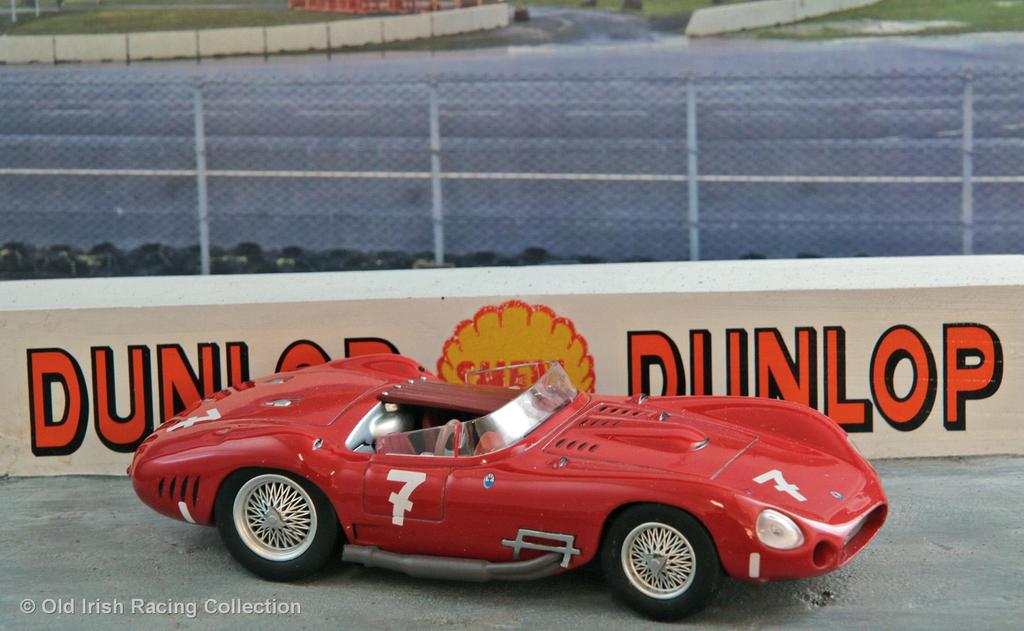 |
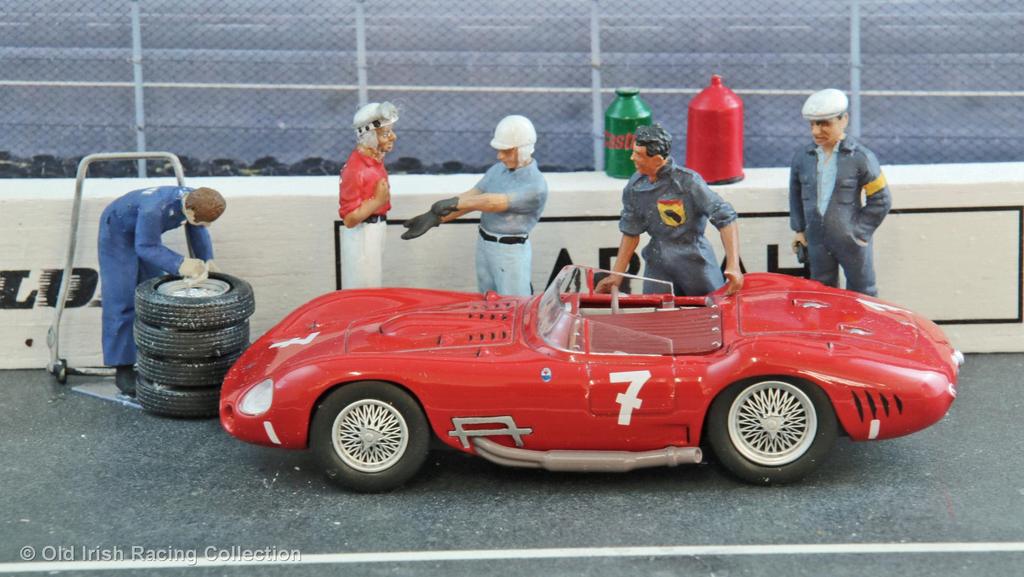 |
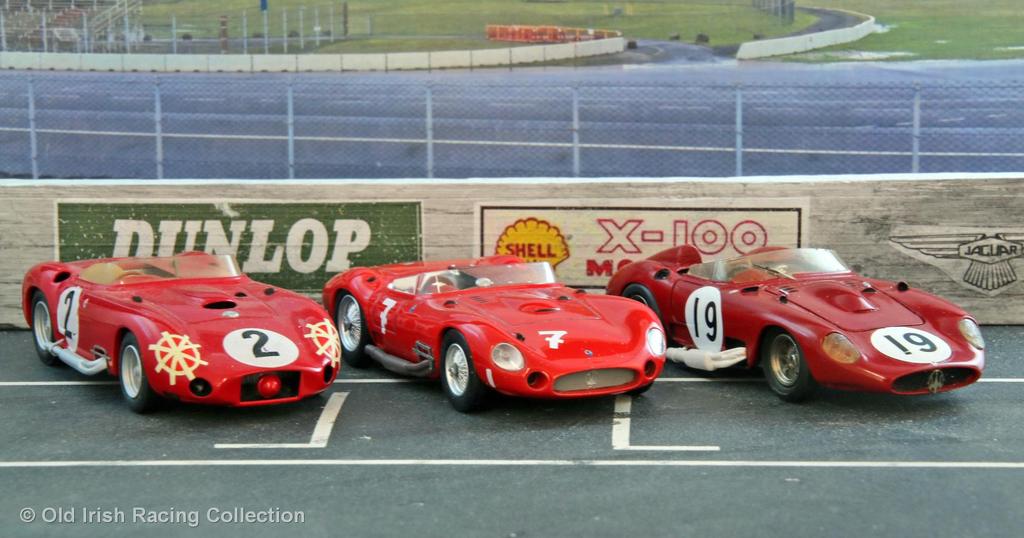 |
 |
1957 Maserati 450S (Swedish GP 1957 - Winner): The Swedish GP was run as a round of the World Sports Car Championship for the last time in 1957. It was a battle between the factory teams from Ferrari and Maserati, with stiff competition also coming from the D-Type Jaguars of Ecurie Ecosse and Equipe National Belge. It was to be Maserati's day, as the 450S dominated both the race and qualifying. Stirling Moss would share the winning car with Jean Behra, as well as drive both of the other two team cars during the race.
Model by LEO 1/43 |
1957 Maserati 450S (Swedish GP 1957 - Winner): Behra had put the Maserati on pole, but Moss in the other 450S shot into an early lead, with Behra reclaiming it after the first half hour of the six-hour race. A pair of Ferrari 335 Sports were in close pursuit driven by Hill/Collins and Hawthorne Musso. After the first pit stop, Harry Schell replaced Moss and Moss replaced Behra in the lead 450S. At half distance, Behra again took over the lead car and Moss took over from Schell. A short time later, the Moss/Schell 450S expired and on the next pit stop, Moss climbed behind the wheel of his third car of the race, the factory 300S which was then in sixth place.
Model by LEO 1/43 |
1957 Maserati 450S (Swedish GP 1957 - Winner): Behra continued to set a blistering pace and the Ferrari's began to experience brake problems. Moss wringing all he could from the 300S had moved up past the D-Types and managed to split the Ferrari's at the end to finish 3rd. The Hill/Collins Ferrari finished in second a lap down to Behra and the second Ferrari was fourth, the Equipe Belge D-Type rounding out the top five. It was a dominating win for the Maserati team and showed what could have been had they been able to hold it all together over the entire season.
Model by LEO 1/43 |
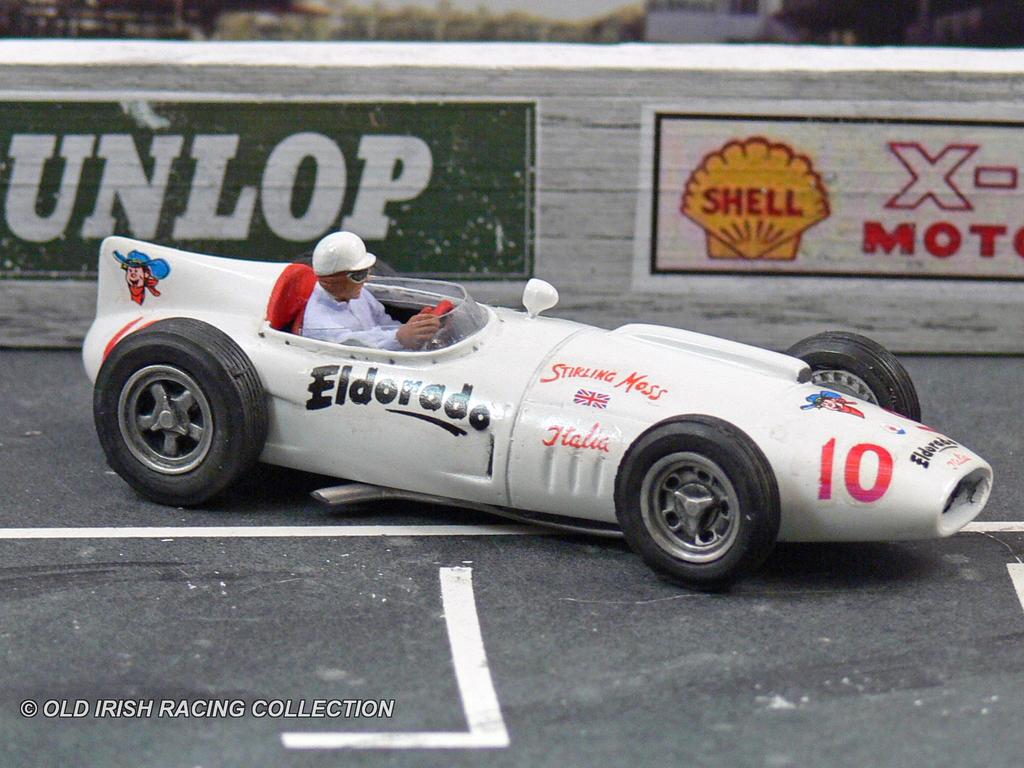 |
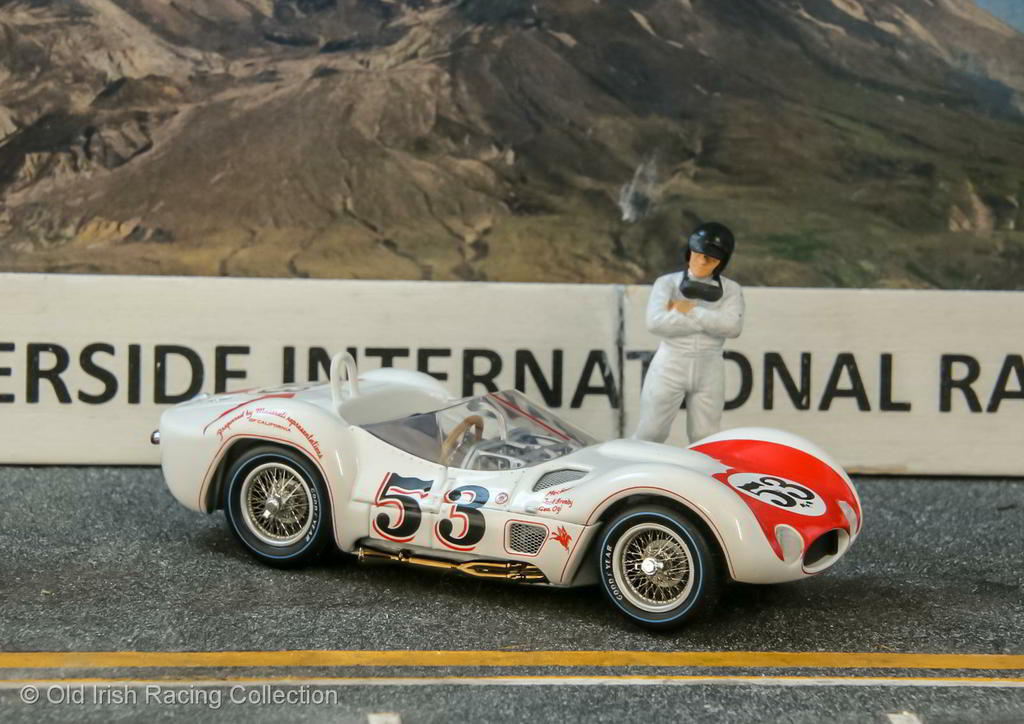 |
 |
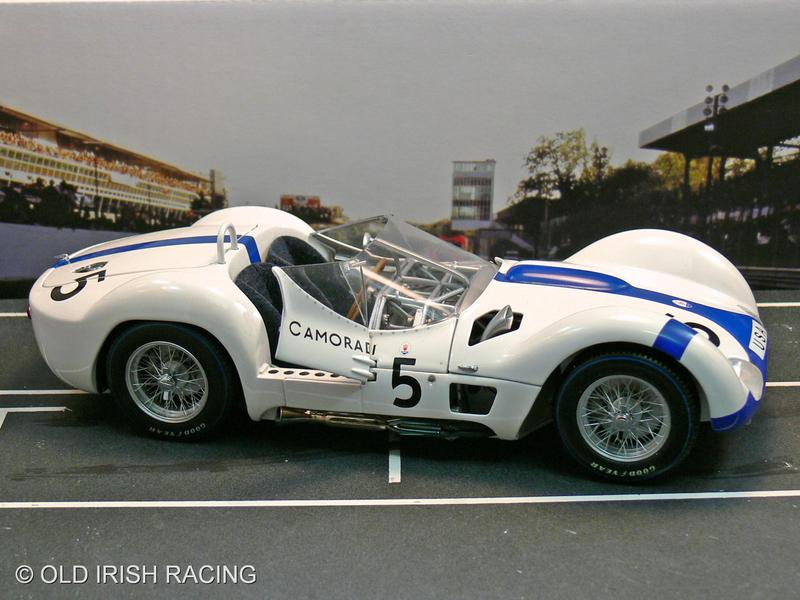 |
1958 Maserati 420M (Monza 500, 1958): Driven by Stirling Moss and sponsored by the Eldorado ice cream company, the car was purpose built for the Monza 500 and the track's steep banking. It has a 4.2L V8, which produces 410 bhp. It did well in the first two rounds. However, in the third round, the steering collapsed on the 40th lap, sending Moss off the track at 162 mph. Amazingly, he was unhurt and the car was still ranked seventh at the end of the race.
Model by STRIPPED PINE 1/43 |
1960 Maserati Tipo 61: This is one of the best known sports racing cars of the early 1960s. Besides winning races, it became famous for its intricate tubular space frame chassis, containing about 200 chro-moly steel tubes welded together, hence the nickname "Birdcage". The Tipo 61 featured a 2.9L, 4 cyl.engine of 250 hp. George Humiston entered this car for Bill Krause to drive at the 1960 LA Times GP at Riverside, which Krause won.This car also raced often in the Pacific Northwest.
Model by MINICHAMPS 1/43 |
1960 Maserati Tipo 61: Jim Hall drove this car for Carrol Shelby during the 1960 and part of the 1961 season in both USAC and SCCA races. Hall finished 2nd at the Road America 200,among the more notable outings in this car. Part way through the 1961 season, Hall began driving the Chapparal 1 and by 1962, drove almost exclusively cars that had the Chapparal name on them. The rest is history.
Model by MINICHAMPS 1/43 |
1960 Maserati Tipo 61: The 'Birdcage' was produced between 1959 and 1961 by Maserati for racing in the 24 Hours of Le Mans. Reliability issues with the Tipo 61 made it unsuccessful at the La Sarthe circuit. It did do well however on shorter endurance races. A Birdcage won the Nurburgring 1000km race in 1960 & 1961. This is the 1960 winner driven by Stirling Moss and Dan Gurney. Lloyd "Lucky" Casner founded the Casner Motor Racing Division, or Camoradi, famous for campaigning these cars.
Model by MINICHAMPS 1/18 |
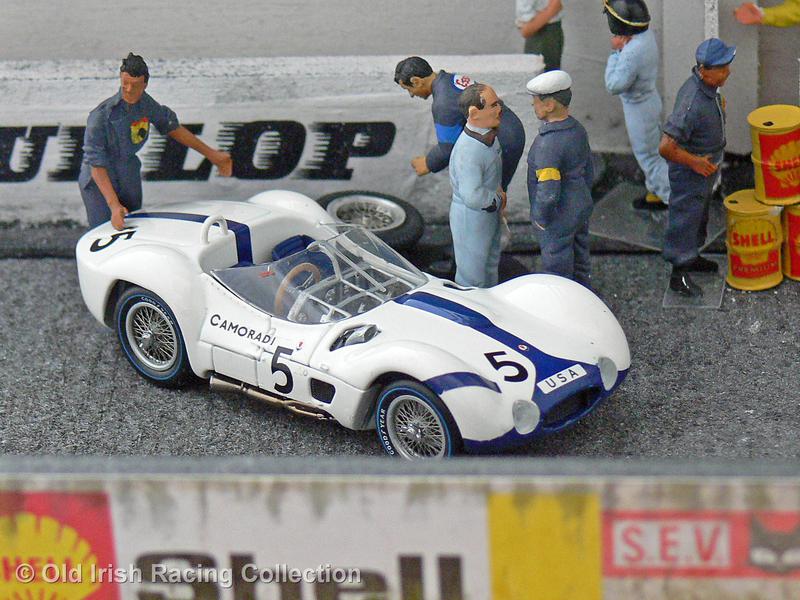 |
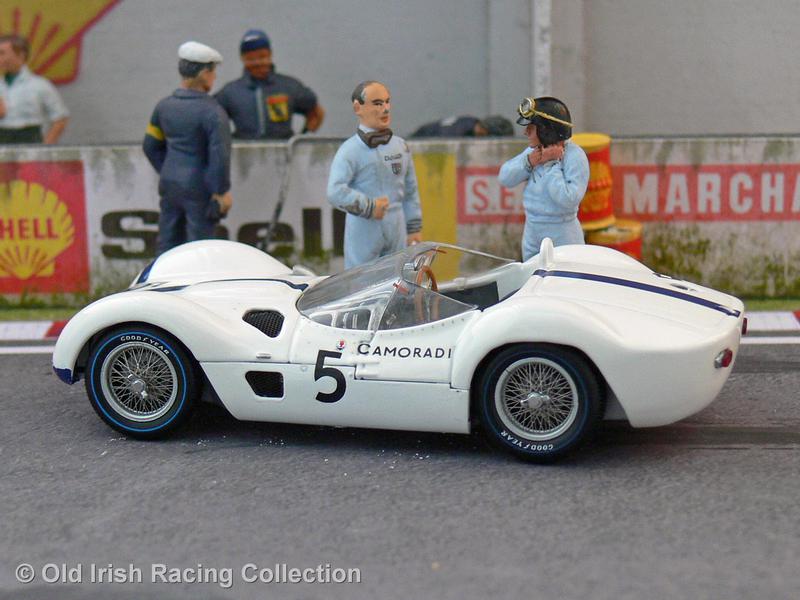 |
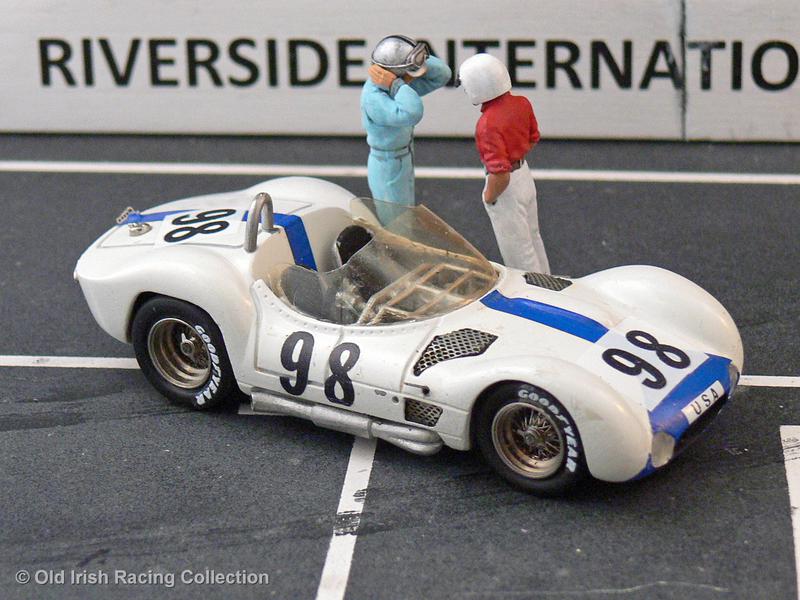 |
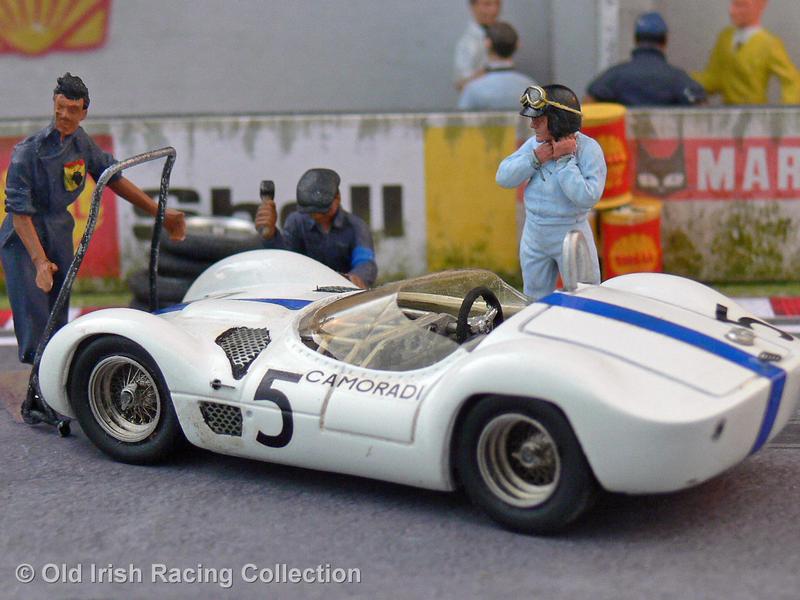 |
1960 Maserati Tipo 61: Introduced in 1959, the main difference between the Tipo 60 and the Tipo 61 Maserati's is the size of the engine. The Tipo 60 has a 2.0L 4-cylinder (200 bhp) and the Tipo 61 had a larger 2.9L engine (250 bhp). Both cars featured the same sophisticated tube frame chassis ("Birdcage"). Maserati had no factory team, so racing of the Birdcage was done by privateers. Lloyd 'Lucky' Casner purchased five cars for his Camoradi racing team. The Tipo 61 was down on power to much of its competition, but its superior handling was its advantage, especially on the Nurburgring where it won back to back victories in the 1000 Km race in 1960 & 1961. This car (Ch #2461) driven by Stirling Moss and Dan Gurney to victory at the Nurburgring in 1960. The car was subsequently made into a long-tail version and raced at Le Mans in 1960 where it did not finish due to failed electrics.
Model by MINICHAMPS 1/43 |
1960 Maserati Tipo 61:
Model by MINICHAMPS 1/43 |
1960 Maserati Tipo 61: In one of the first races for Camoradi USA in a Tipo 61, Stirling Moss won the GP of Cuba in early 1960 in this car (Ch.#2458). It was then driven at Sebring that year by Moss and Dan Gurney but retired due to transmission failure. Carroll Shelby then drove this car in the first round of the 1960 USAC Road Racing Championship at Riverside. Shelby's win over the second place car (Porsche 718 RS) by over a minute and almost two over the third place Ferrari demonstrated its ability to dominate the competition in the hands of a good driver and provided it held together. Shelby would go on to win the season Championship in his last year of racing as a driver. With the new Tipo 62 being introduced, Camoradi sold the car to Jim Hall of Chaparral fame, who drove and sponsored the car in SCCA racing where it ran under various owners until 1965.
Model by AMR 1/43 |
1960 Maserati Tipo 61:
Model by AMR 1/43 |
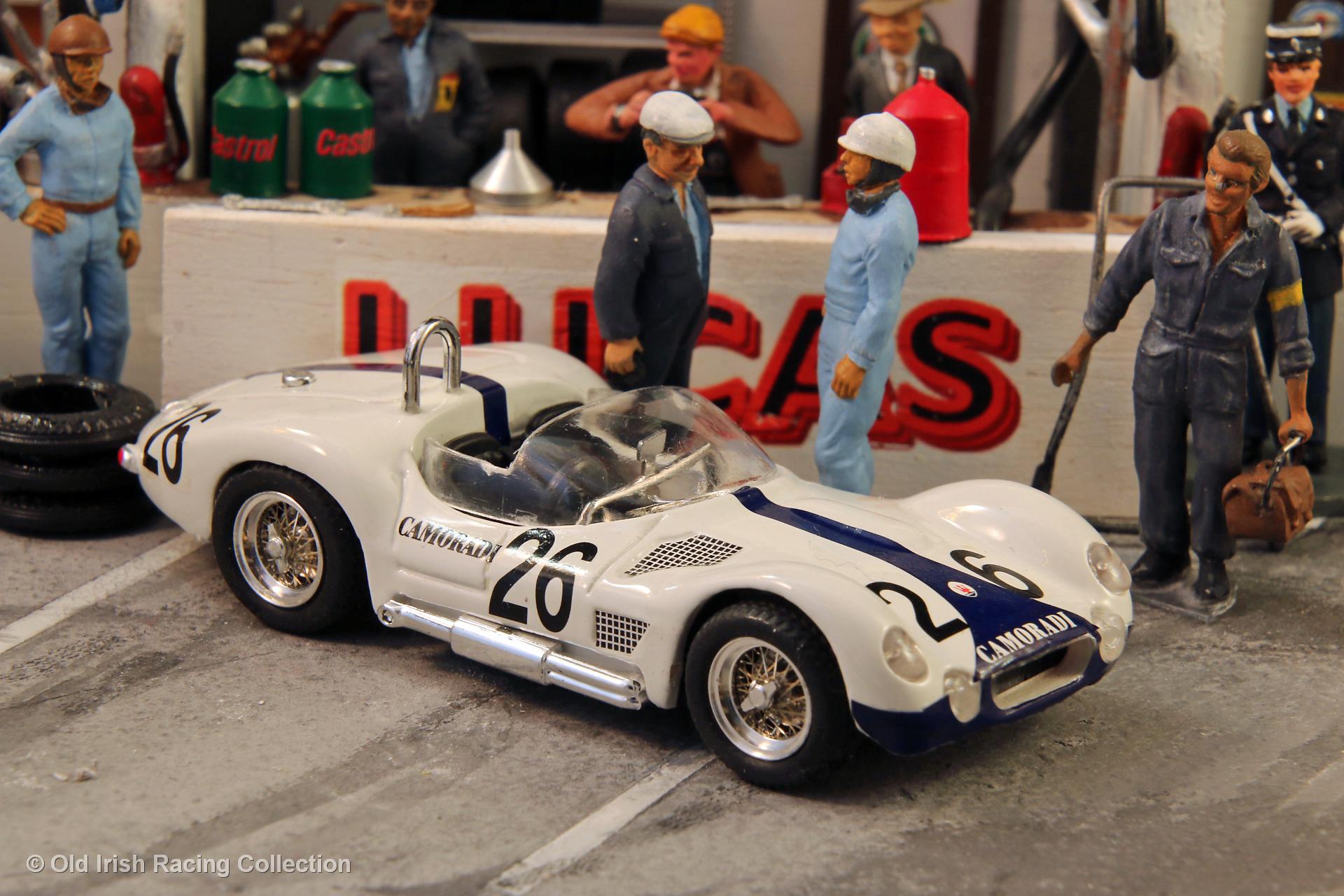 |
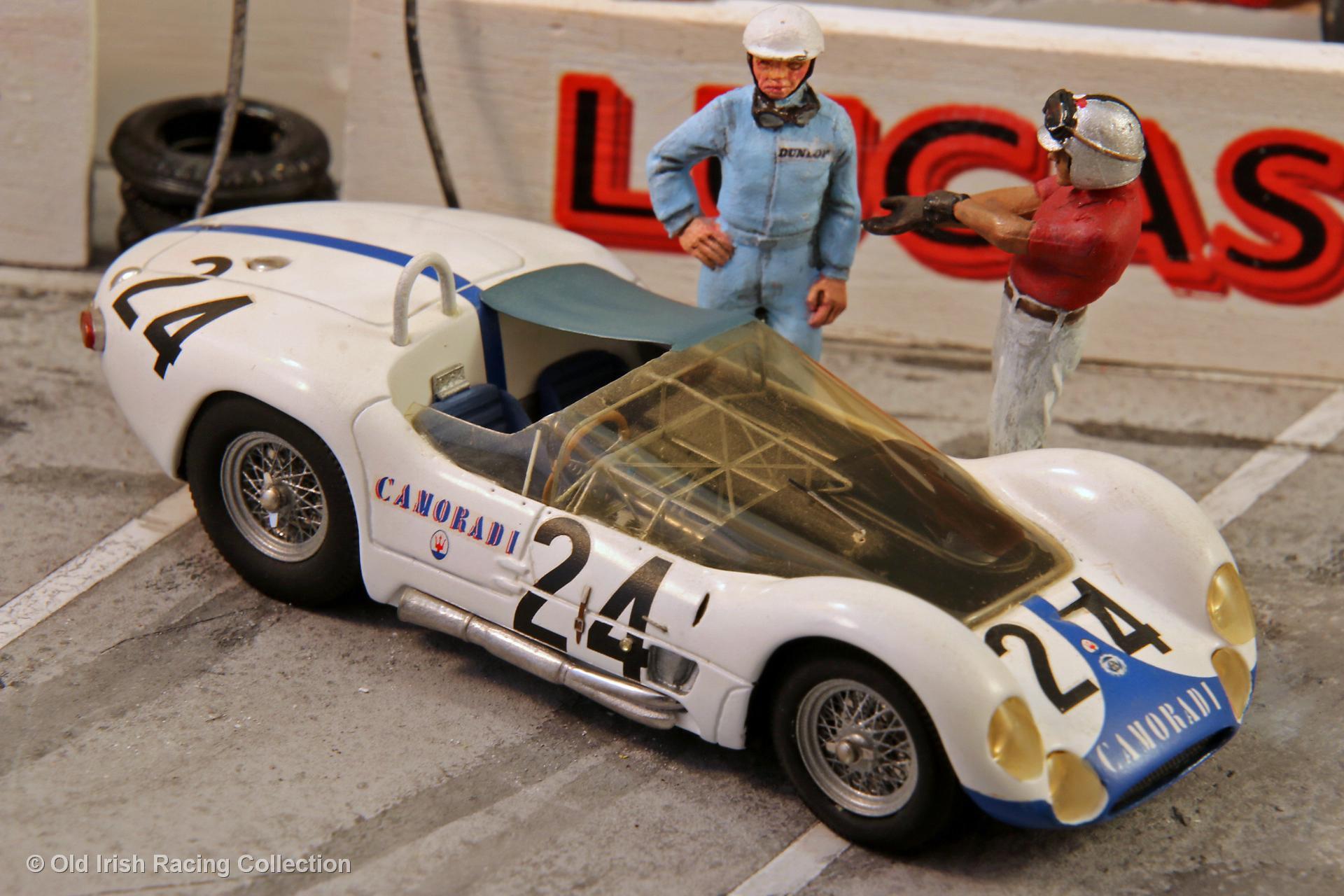 |
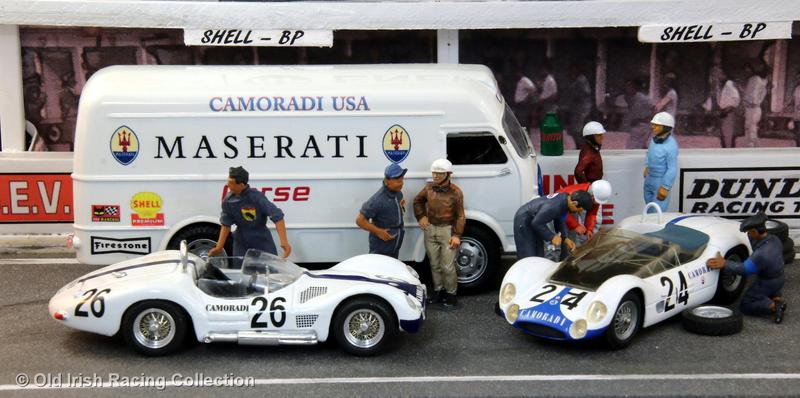 |
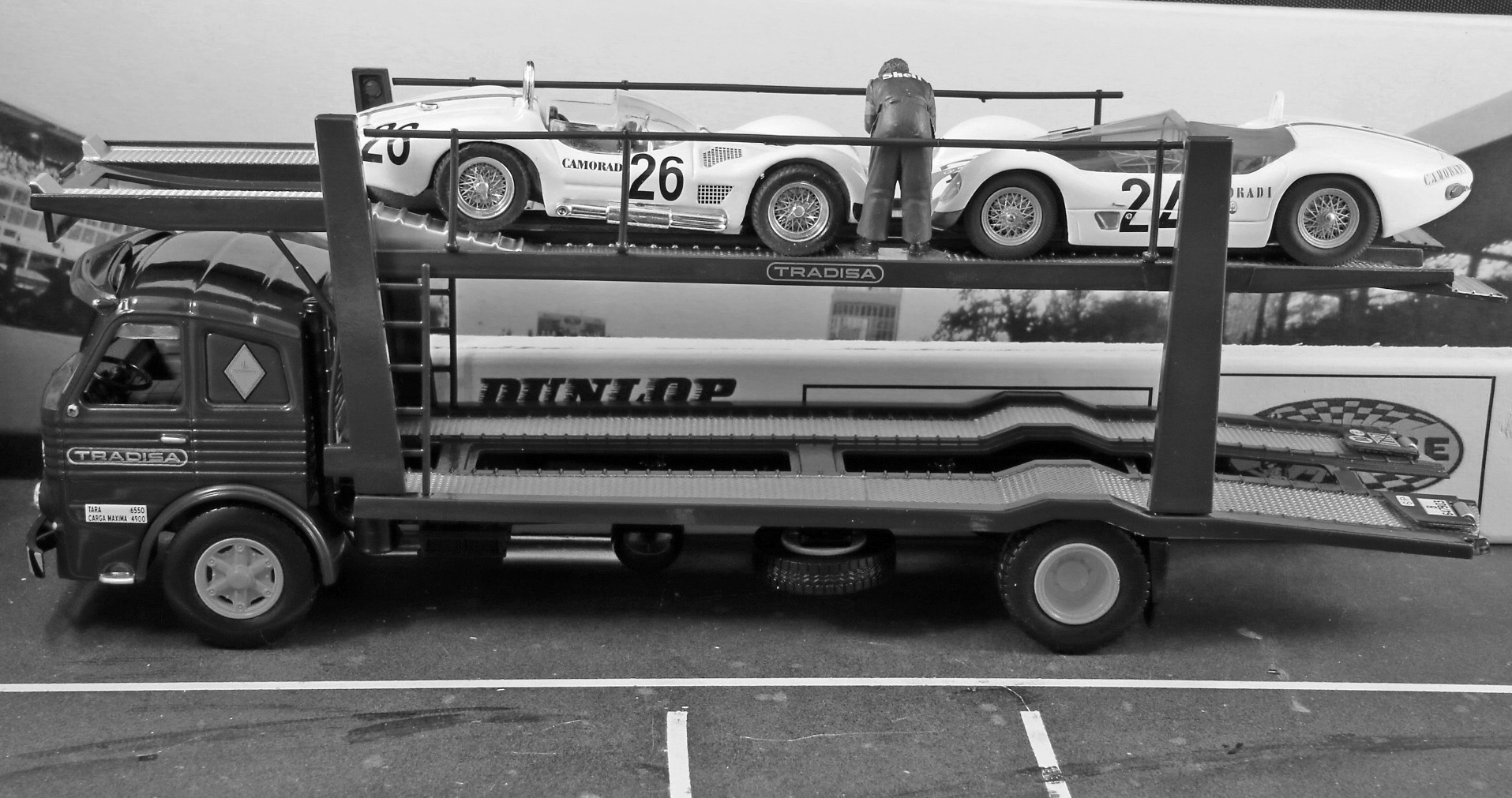 |
1960 Maserati Tipo 61 Longtail (Le MANS 1960): Lucky Casner's Camoradi (Casner Motors Racing Division) racing team brought three Maserati T61's to Le Mans in 1960. Casner funded his racing by sponsorship and sponsorship by Goodyear allowed him to purchase two new T61 Longtails specifically for Le Mans in 1960. One of the first professional racing teams, sponsorship money also allowed him to hire front line drivers. This car was driven by Gino Munaron and Giorgio Scarlatti at Le Mans in 1960. Despite the talent of the pair of Maserati factory drivers, when after having been as high as 8th position, their race came to an end as the torrential rains drowned their car's electrical system in the third hour. This car (Ch. #2461) had won the Nurburgring 1000 Km with Stirling Moss and Dan Gurney the month before Le Mans.
Model by EXEM 1/43 |
1960 Maserati Tipo 60/61 Longtail (Le Mans 1960: Of the three Camoradi Maserati's entered at Le Mans in 1960, this T60 (Ch. #2451) which was converted to T61 Longtail specification after the car was crashed on the Targa Florio. Like the T60, the T61 was powered by Maserati's 2.9L four-cylinder engine, which besides being powerful, was also fuel efficient. Maserati had found a way to circumvent new Le Mans rules for windshield height, by making one 60" long, which sloped up to the minimum height requirement. Masten Gregory and Chuck Daigh drove this car and Gregory passed 20 cars to lead the first lap. He had a recorded top speed of 170 mph and was leading by 70 seconds when they made the first pit stop, but the car wouldn't restart. They lost an hour in the pits replacing a starter. Despite the drivers efforts to make up time and position, in the 9th hour after 82 laps the car came to a halt with electrical failure. The other two Casner cars would also retire, one due to electrics, the other due to sand in the gearbox after an off road excursion.
Model by SOUTHERN CROSS MINIATURES 1/43 |
Camoradi USA Team at Le Mans 1960
|
|
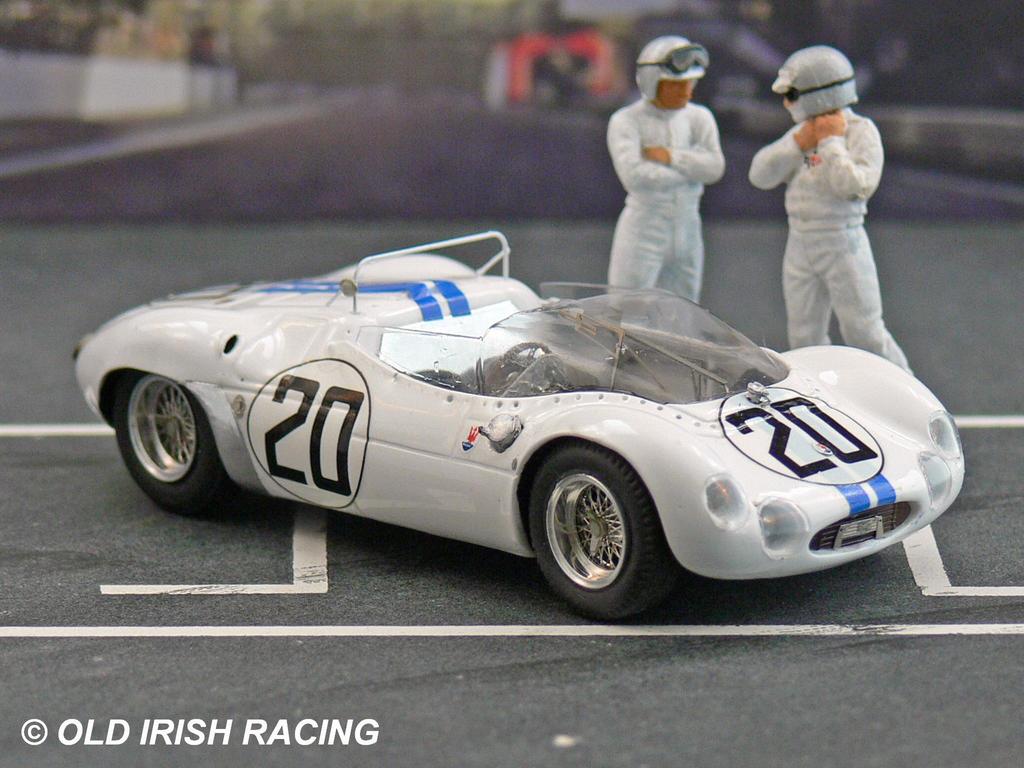 |
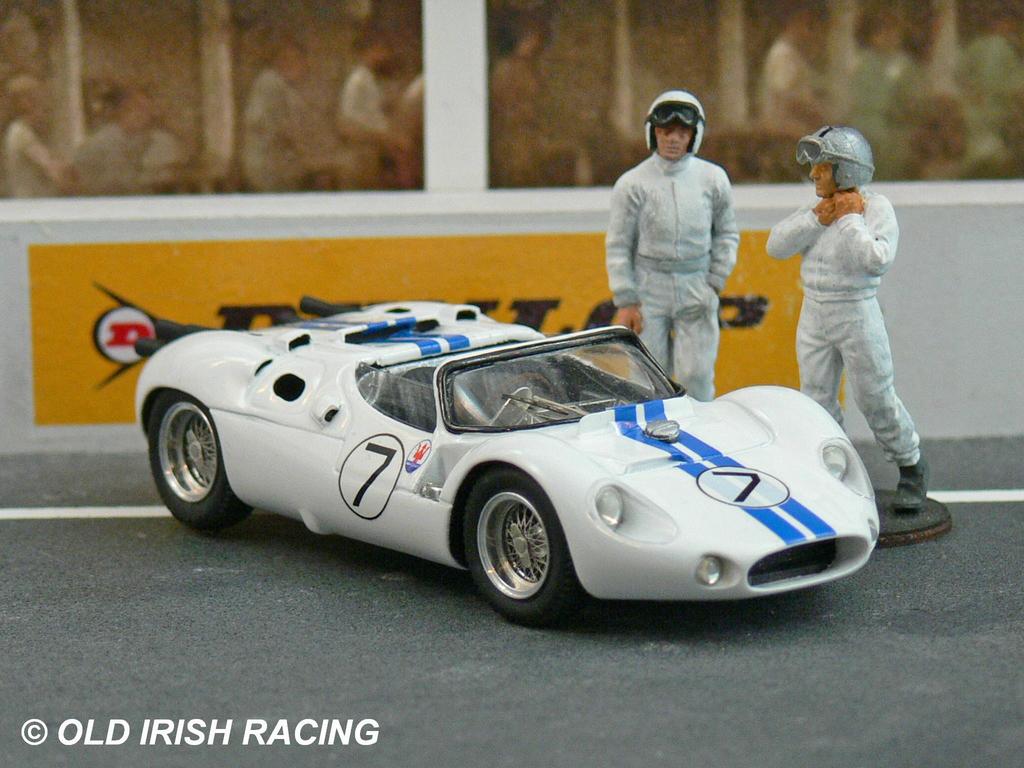 |
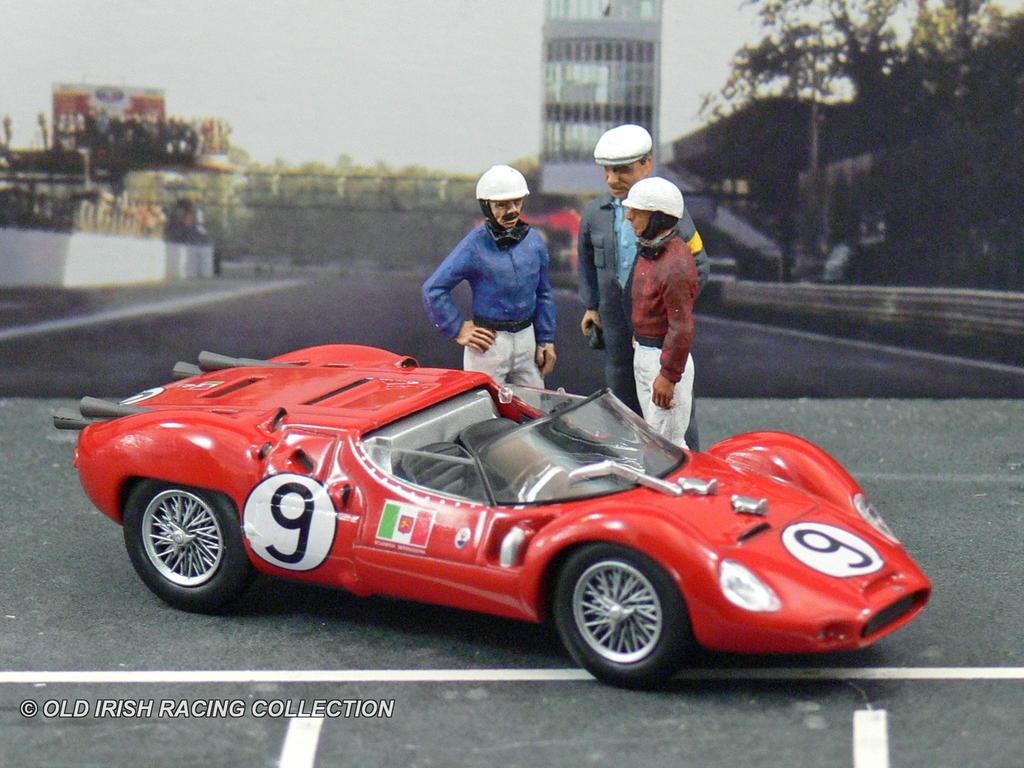 |
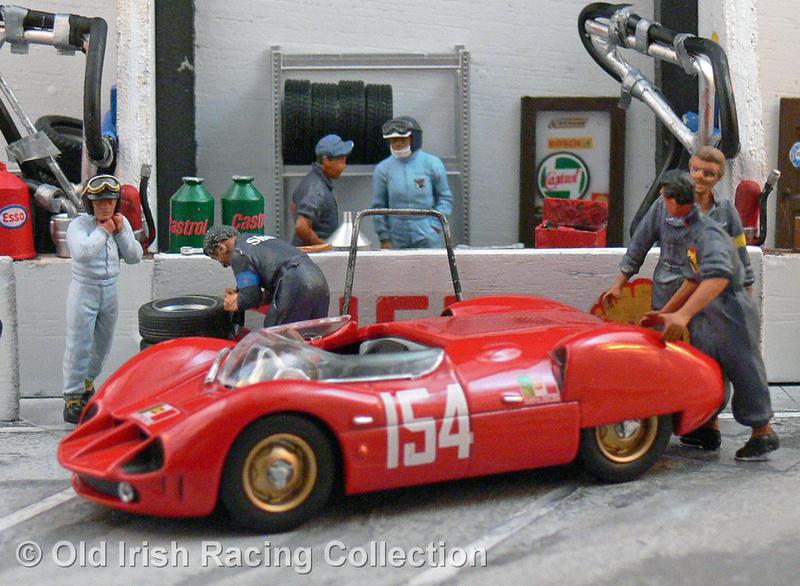 |
1961 Maserati Tipo 63 (Sebring 12-Hours, 1961): Using the Tipo 61 'Birdcage' engine and chassis, Maserati developed the mid-engine Tipo 63 for the 1961 season. Before the year was out, the car would sport a V12 engine rather than the Birdcage's four and it would suffer reliability problems all season. Cunningham entered his Tipo 63 (Chassis #63002) at Sebring in 1961 with Bruce McLaren and Hansgen driving. They did not finish due to transmission problems. The large pexiglass windscreen on these cars made it hard to see through and hard to see over, the front end design would get changed after Sebring.
Model by GAMMA 1/43 |
1961 Maserati Tipo 63 (Le Mans, 1961): The Tipo 63 was one of Italy's first mid-engined sports racers. Designed to take a 3.0L V12, the new engine was not yet available and the car was fitted with a 'four' from the earlier Birdcages. For Le Mans in 1961, the cars were fitted with the new DOHC V12 derived from the engine briefly used in the 250F and 350S in the 1950s. Briggs Cunningham entered two cars for Le Mans and this car piloted by Augie Pabst and Richard Thompson finished fourth; the best ever result for Maserati at Le Mans.
Model by PINKO/GAMMA 1/43 |
1961 Maserati Tipo 63 (Le Mans, 1961): Fresh off the success at the Targa Florio, (4th and 5th) Scuderia Serenissima entered this car for Ludovico Scarfiotti and Nino Vaccarella at Le Mans in 1961. Despite being old hands at endurance racing, the pair could not keep the 3.0L V12 Maserati running past the 7th hour, A blown head gasket would put them out of the race.
Model by LEO 1/43 |
1962 Maserati Tipo 64 (Mille Miglia, 1962): Tipo 64 was a smaller, lighter car than the Tipo 63 and was the size of its direct competition, the Lotus 19. The Tipo 64's birdcage chassis was entirely new, using smaller diameter tubing and redesigned front and rear suspension. It was nicknamed the "Supercage". The car was powered by the same 3.0L V12 in the Tipo 63. Two chassis were built with one going to the Camoradi team, and this car going to Scuderia Serenissima, which had a special pointed nose applied. This car first raced Sebring in 1962 where it failed to finish. As seen here, it was entered in the Mille Miglia, where it also failed to finish with Carlo Abate and Colin Davis driving. Count Volpi gave up on Maserati and a planned Le Mans run never happened.
Model by LEO 1/43 |
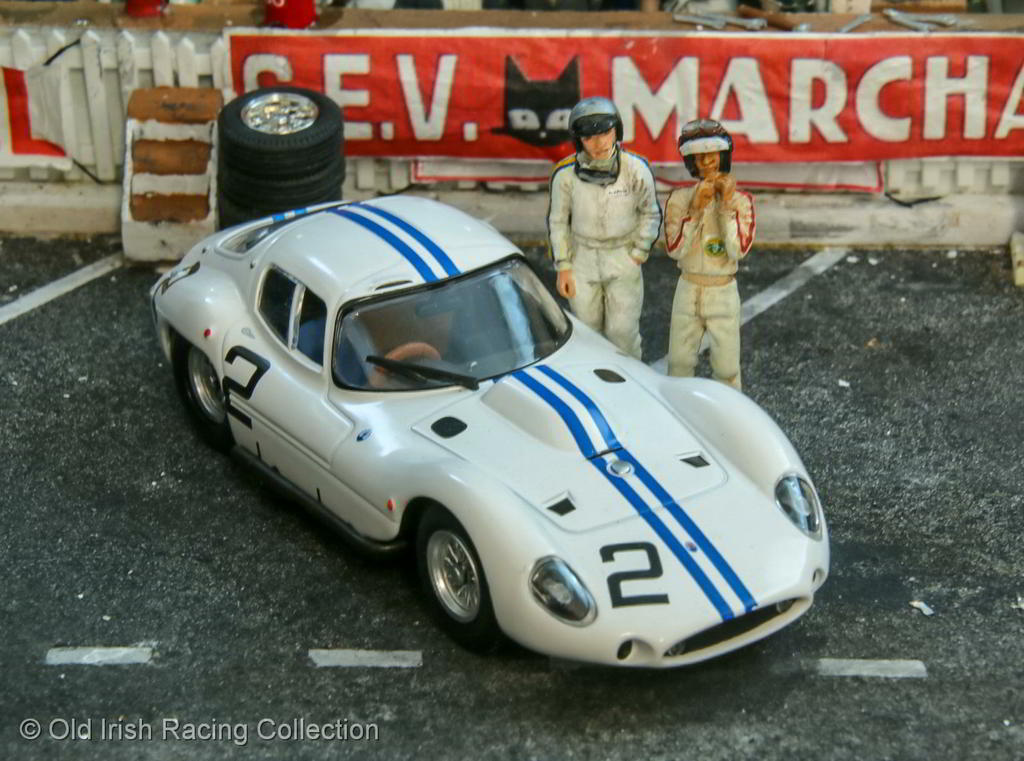 |
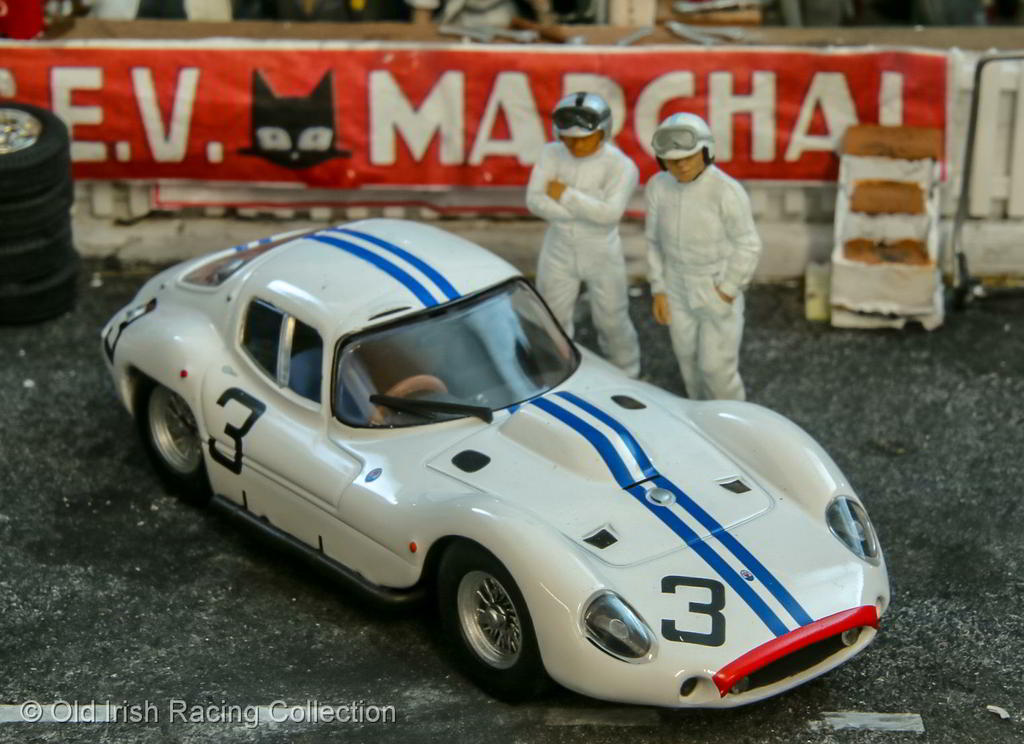 |
 |
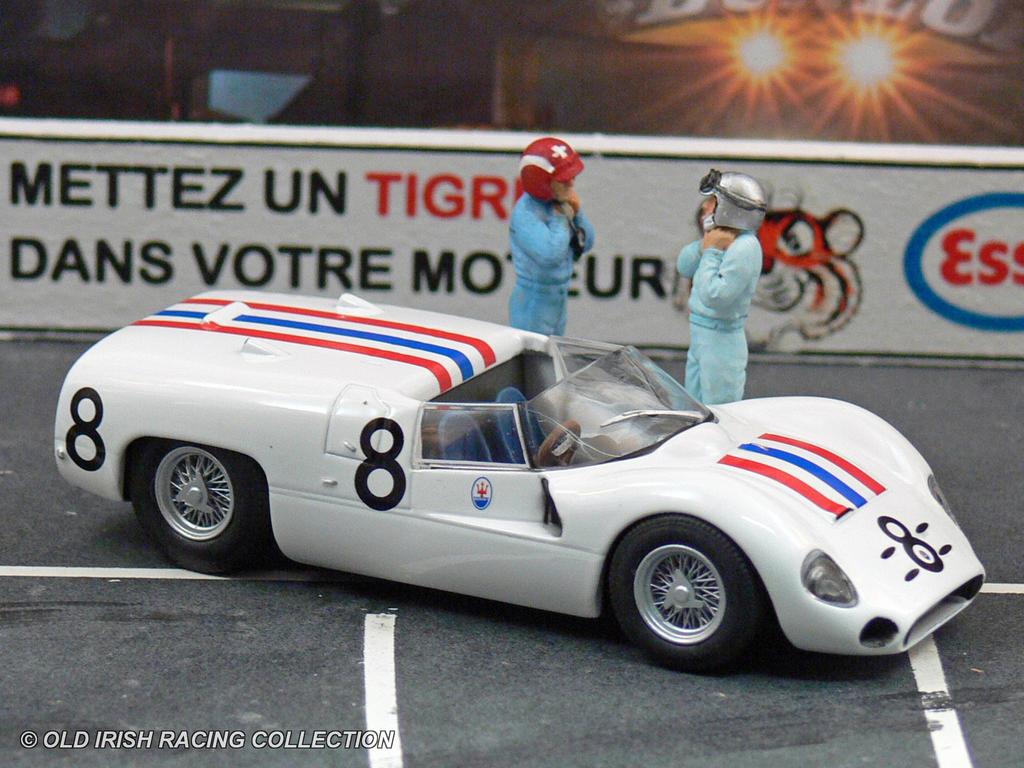 |
1962 Maserati Tipo 151 Coupe (Le Mans, 1962): Walt Hansgen and Bruce McLaren drove one of the two Cunningham entered 151/1 Coupes at Le Mans in 1962. After running as high as 2nd, and a long delay due to a thrown tire tread, McLaren had worked the car back to 5th position. However, they retired in the 13th hour due to piston and transmission failure. They had qualified 5th fastest, being as high as third place and were in 5th place when they retired.
Model by LEO 1/43 |
1962 Maserati Tipo 151 Coupe (Le Mans, 1962): William Kimberly and Dick Thompson drove the second Cunningham enty (Ch. #006) at Le Mans in 1962. After qualifying the car 3rd on the grid, they were in the top four when Thompson spun the car in the Esses, hitting a barrier and ending their race in the 4th hour. There were three 151 Coupes with their distinctive Kamm tails built for Le Mans in 1962, unfortunately all retired.
Model by LEO 1/43 |
1962 Maserati Tipo 151 Coupe (Le Mans, 1963): This Tipo 151 was made for John Simone and entered by Maserati of France for Le Mans in 1962. Using a Costin inspired body over a tube/ladder frame, this 151 was to race at Le Mans for four years. Lucky Casner and Andre Simone drove this car in the 1963 Le Mans, and the car was the fastest on the straights. From 1962 it was lightened and the engine size increased from 4.0L to 4.9L and produced 430 bhp (180 mph). After leading, the car retired due to gearbox trouble
Model by GARNINI 1/43 |
1965 Maserati Tipo 65 (Le Mans, 1965): Following Lucky Casner's death in pre-Le Mans testing of a 151 Coupe, Maserati France boss John Simone has a new car built around Tipo 61 chassis, with a mid-mounted 5.0L V8 developing 430bhp, in seven weeks! It proved to be a beast to handle with no proper testing. Its drivers Jo Siffert and Jochen Neerpasch were brave to try the 24 hours, let alone see if it could do the 217mph it was claimed to be capable of. Siffert spun the car in the 1st hour and damaged the suspension retiring the ill-handling car.
Model by LEO 1/43 |
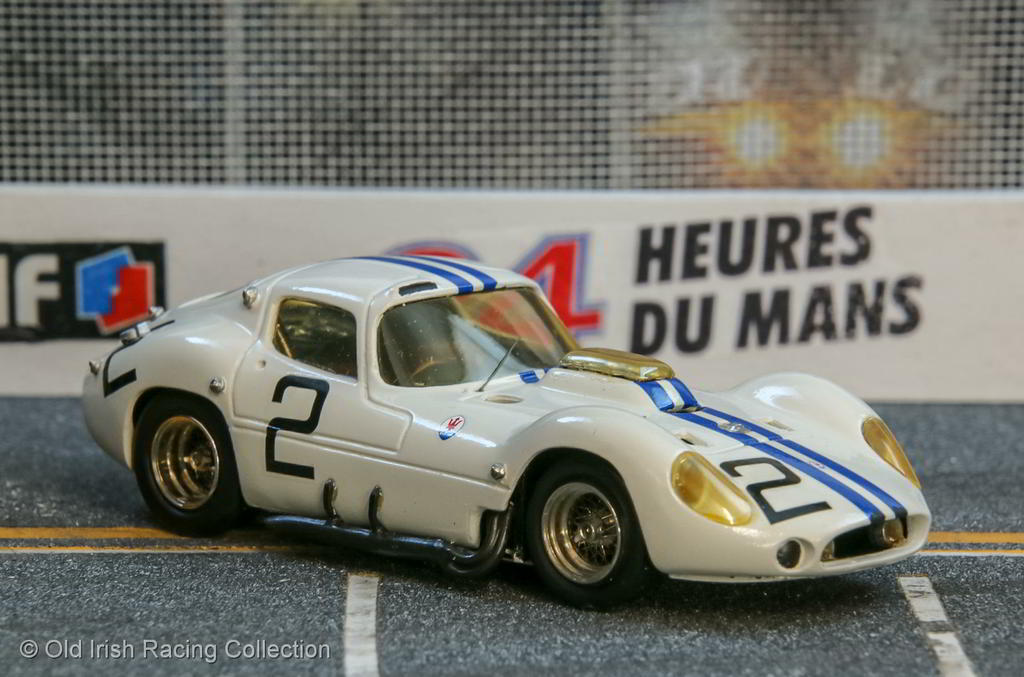 |
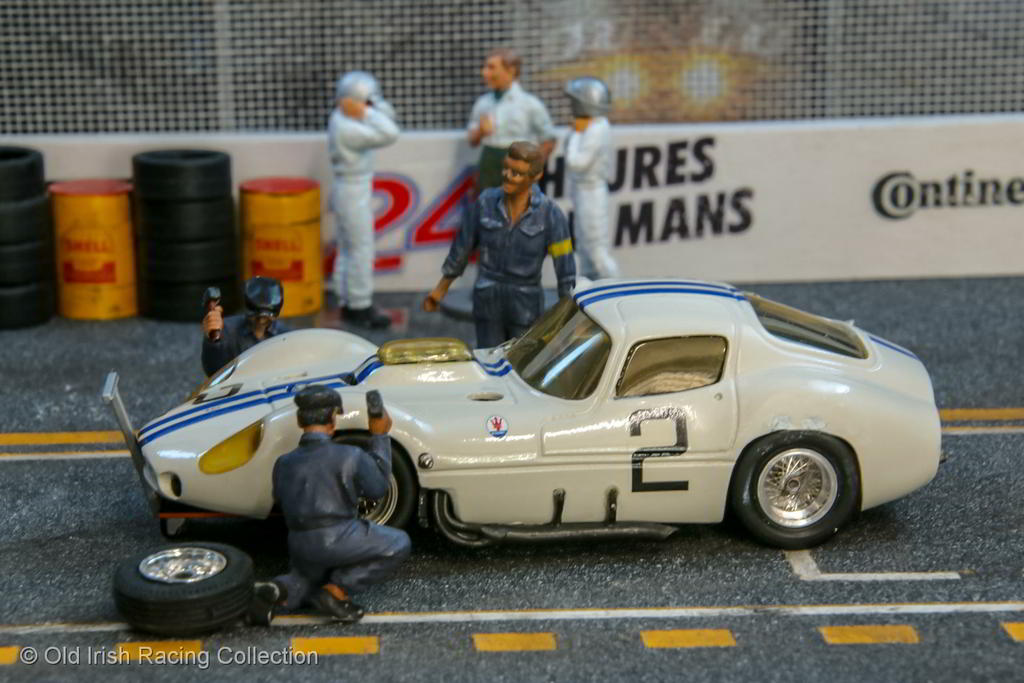 |
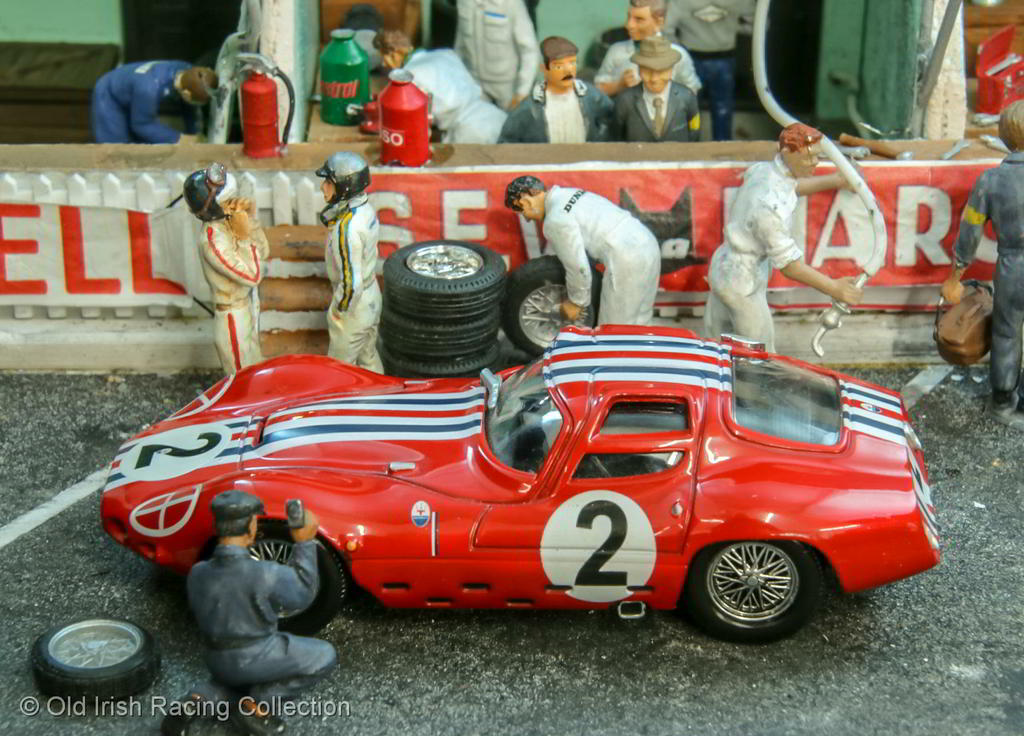 |
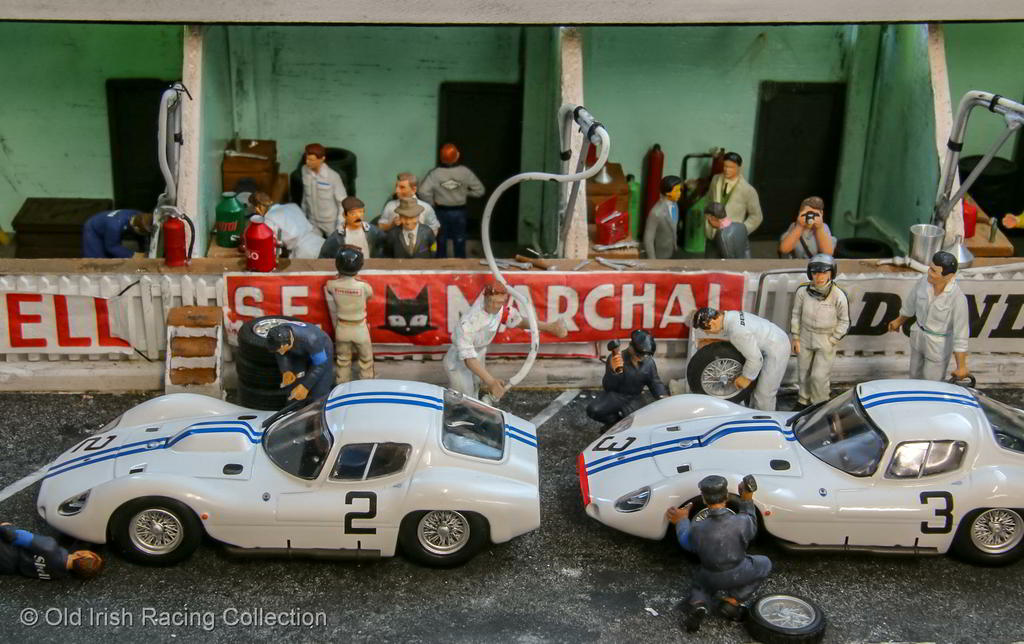 |
1962 Maserati Tipo 151 Coupe (Le Mans, 1962): Maserati technical director Giulio Alfieri rejected the mid-engine T63 and birdcage chassis, believing the power of the 4.0L quad-cam v8 engine from the 450S could only work in a front-engined car. Using a design originally conceived by Frank Costin, the 360 bhp car was one of the fastest at Le Mans at a top speed of 177 mph. Three cars were built, two for Briggs Cunningham and one for Col. John Simones Maserati France.
Model by AMR 1/43 |
Maserati Modern Day Racing
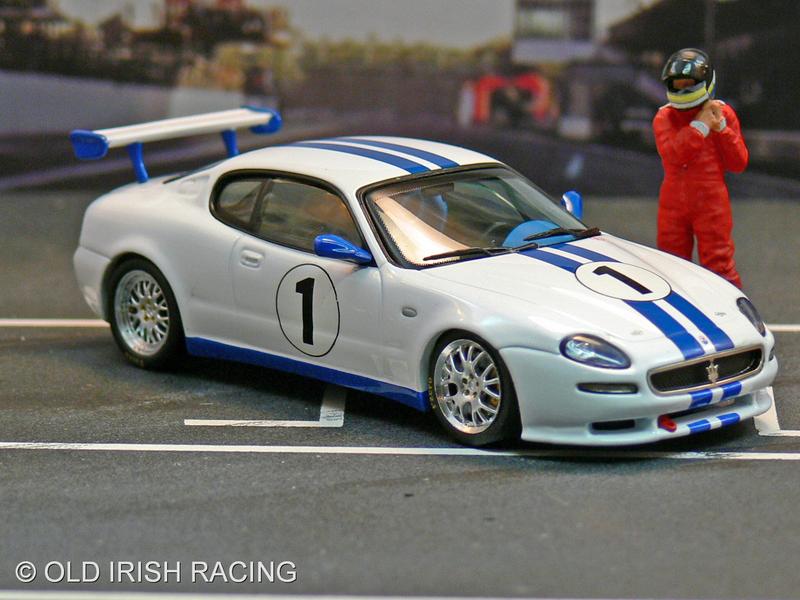 |
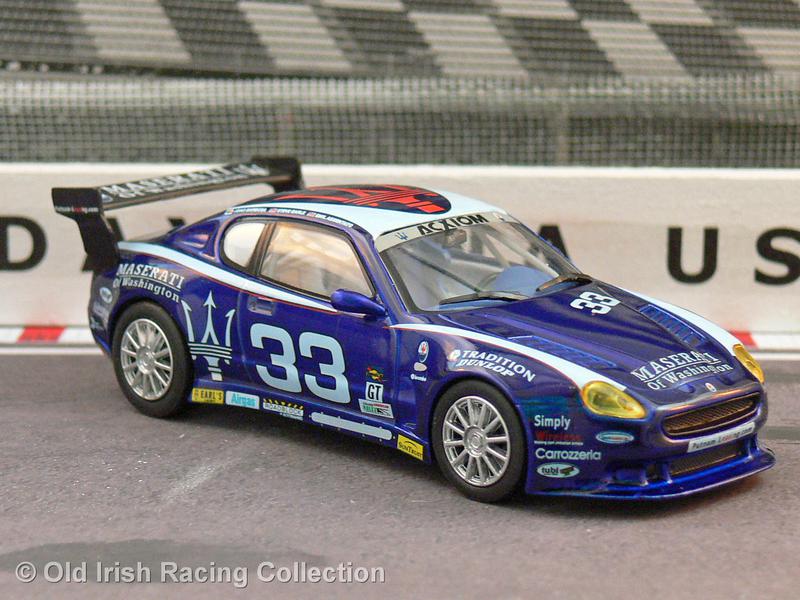 |
 |
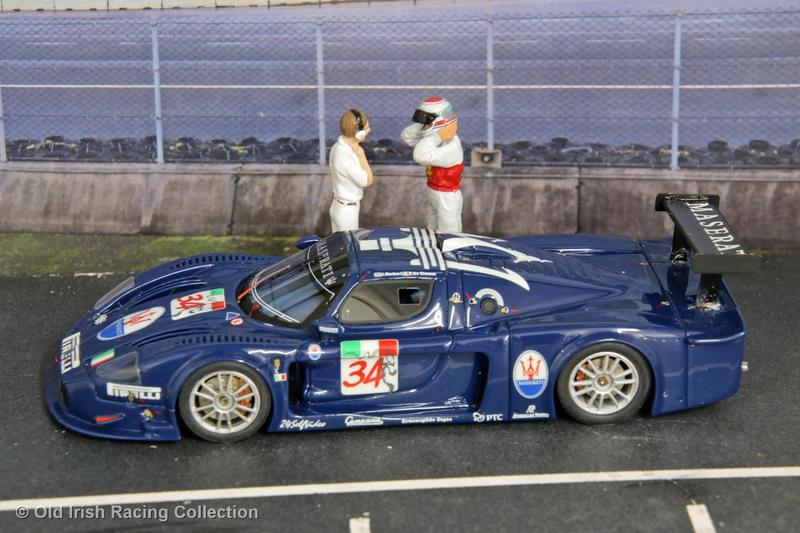 |
2003 Maserati (4200 GT) Trofeo: The Maserati Trofeo is a racing version of the 4200 GT that was introduced in 2003. It is powered by a 4.2L V8 which produces 414 hp. The Trofeo weighs 550 lbs less than a stock coupe due to being stripped of all unnecessary weight and the use of carbon fiber body panels. A Trofeo racing series was organized for enthusiasts, with a per-race rental charge of about $20,000. This is the presentation car from the press launch of the racing series.
Model by IXO 1/43 |
2004 Maserati (4200 GT) GranSport Trofeo Light: Scuderia Ferrari of Washington entered this Trofeo Light in the 2004 Rolex Grand-Am Championship, to be driven by Americans Emil Assentato and Steven Earle, along with Joao Barbosa of Portugal. While BMW dominated the GT class in this endurance series, along with stiff competition from Porsche and Ferrari; the trio managed to often place in the top 20 and were usually in the top five finishers in their class. Their best finish of the season was 12th overall and 3rd in class at the Virginia 400Km, which was in the backyard of their sponsor Maserati of Washington. The Maserati Trofeo Light weighed 550lbs less than the stock Trofeo. It was powered but the same 4.2L V8, but produced 414hp and had a top speed just under 200 mph.
Model by LEO 1/43 |
2004 Maserati MC12 GT1 (2004 FIA GT Championship): After a 37 year absence, Maserati in an effort to boost its brand image, decided to get back into racing. They chose the FIA GT Championship and would design a new GT1 car. Being part of the larger Fiat family, the basis for the new car would be the Ferrari Enzo, with the new car being longer, wider and taller than the Enzo. It was also more aerodynamically efficient. The MC12 as the new car was designated, would use the 6.0L Ferrari V12 engine and in endurance race trim, produced 620 bhp. Maserati enlisted AF Corse to test and develop the car, as well as run the racing team, which saw the car on track the last four races of the 2004 FIA GT Championship season. This is the car as it ran the final round of the season, where MC12's finished 1-2. This is the second place car of Johnny Herbert and Fabrizio de Simone.
Model by BBR 1/43 |
2004 Maserati MC12 GT1 (2004 FIA GT Championship): A total of 62 MC12's were built in 2004 & 2005. Fifty cars were production versions to meet homologation requirements and twelve were GT1 specification cars. This car in GT1 specification is Chassis #003/15440, one of the first cars built. The car was deemed too wide and long to race at Le Mans, but was allowed in the FIA GT1 Championship, along with the American Le Mans Series (ALMS). In 2005, this car was campaigned in the AMLS by Maserati Corse run by Risi Competizione. It was the only Maserati to compete in the series. Unlike the FIA Championship which Maserati won in 2005 & 2006, the MC12 would no win a race in ALMS. This car race in Portland in 2005 where it finished 9th.
Model by BBR 1/43 |
Maserati Production Cars
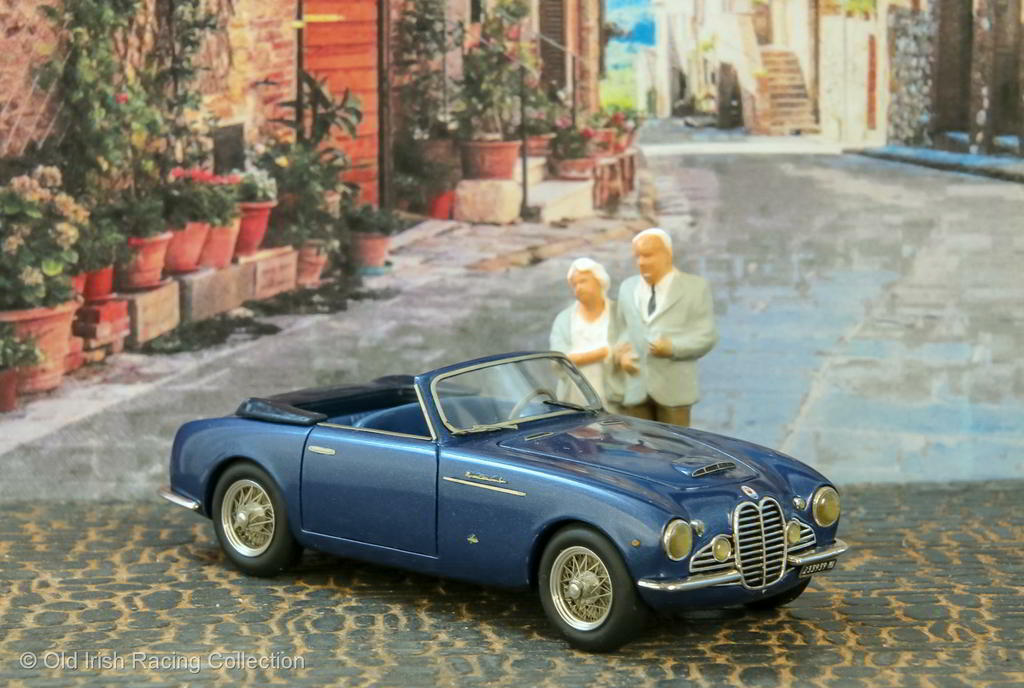 |
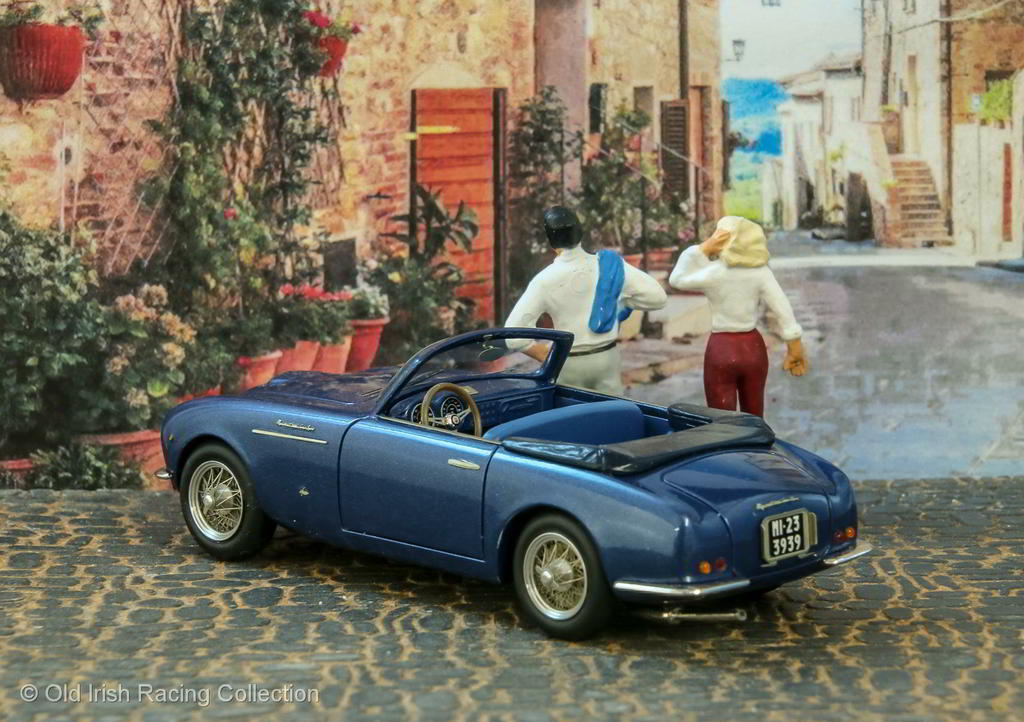 |
 |
 |
1952 Maserati A6G 2000 Frua Spyder: Deemed one of Fruas best creations, the A6G 2000 was built as a replacement to the earlier A6G 1500 series of cars. Approximately 16 cars total were built among three coachbuilders, Frua, Pinin Farina and Vignale. Frua constructed the only spyders (more like cabriolets), the rest were all coupes. The five spyders were built on the short-wheelbase A6G1500 chassis.
Model by TECNOMODEL (kit built by Rodney Rawlings) 1/43 |
1952 Maserati A6G 2000 Frua Spyder: The A6G 2000 used a 2.0L DOHC inline six-cylinder engine with triple carburators, coupled to a five-speed manual transmission. The first three cars had engines from the A6GCS, which could be tuned to produce 150 BHP; with the final two, of which this car is one, used a more street worthy A6G/54 engine, which still produced 100 BHP and a top speed of 112 MPH (180 KPH). A rare and beautiful Maserati which is a great example of 1950s coachwork craftsmanship.
Model by TECNOMODEL (kit built by Rodney Rawlings) 1/43 |
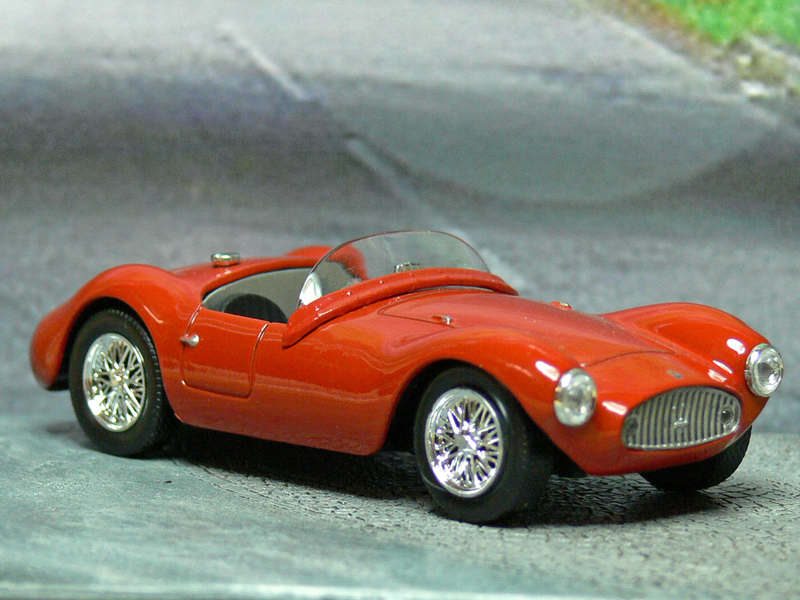 |
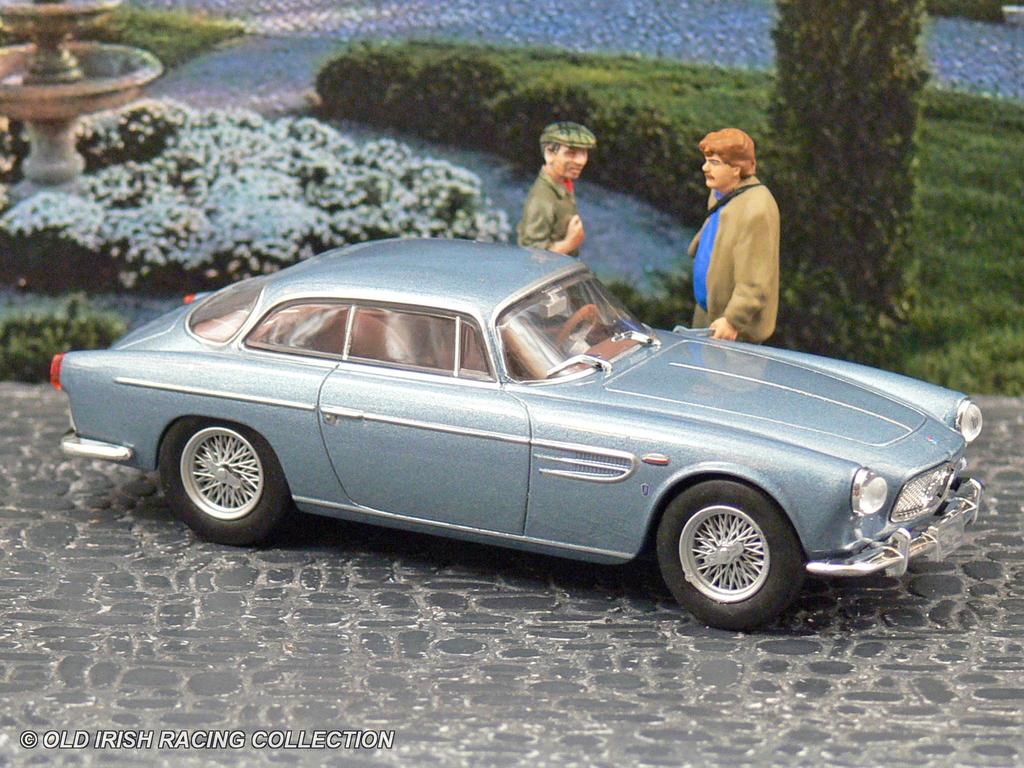 |
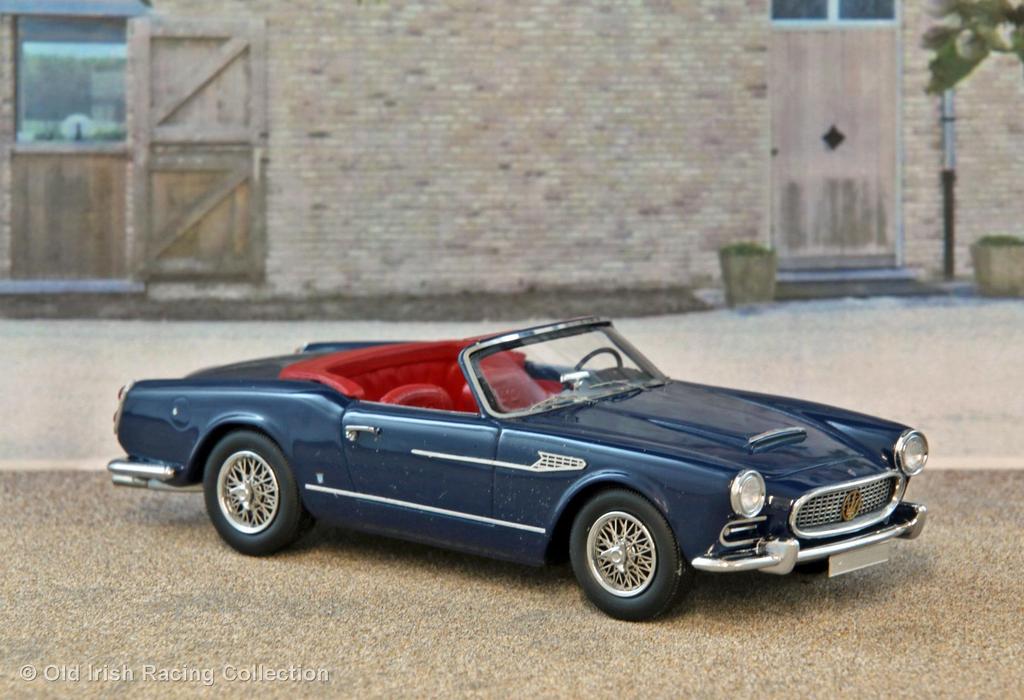 |
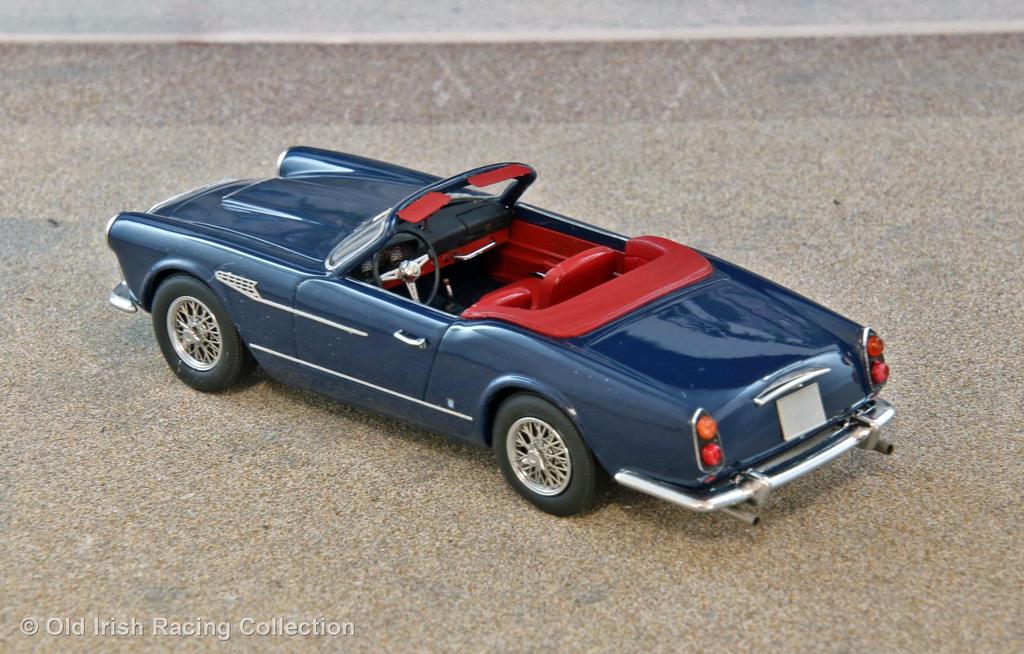 |
1953 Maserati A6GCS: Since these cars were designed primarily for races on open roads, Maserati did produce some street versions for select customers. A 2.0L straight-six (120 bhp) was used in the A6 GCS two-seater. These spyders were initially designed by Colombo and later refined by Medardo Fantuzzi and Celestino Fiandri. Fifty-two were made.
Model by da GRANI & PARTNERS 1/43 |
1954 Maserati A6G/54 Allemano: Also known as the A6G 2000 GT, 21 examples of the Allemano Coupe were made between 1954-56. Maserati placed the DOHC2.0L inline-six, derived from the racing engines of A6GCS and A6GCM in the A6G/54, fed by three twin-choke Weber DCO carburettors it put out 150 hp and had a top speed of 130 mph. Four body styles of the A6G/54 were produced, with body styles by Frua and Zagato as well as Allemano. There were 60 units made total.
Model by LEO 1/43 |
1959 Maserati 3500 Spyder Prototype by Vignale: In 1957, at the height of its racing success, Maserati introduced the 3500 GT to replace the A6GCS, and it was an immediate hit. That car provided a much needed cash infusion for Maserati. Customers wanted an open version of the 3500, so Maserati had Spyder design prototypes built by Frua, Touring and Vignale. They settled on the Michelotti design for Vignale and Vignale bodied the limited production 3500 Spyders. Built on a shortened 3500 chassis, the open car used the same 3.5L in-line DOHC six-cylinder engine as the coupe`, which produced 220hp.
Model by MATRIX 1/43 |
1959 Maserati 3500 Spyder Prototype by Vignale: This car (Chassis #AM101*678) is one of three 3500 Spyder prototypes built by Vignale and it was on the Maserati stand at the 1959 Turin Motor Show when the Spyder version of the 3500 was introduced. Production was from 1960-1964, with 242 Spyders produced during that period.
Model by MATRIX 1/43 |
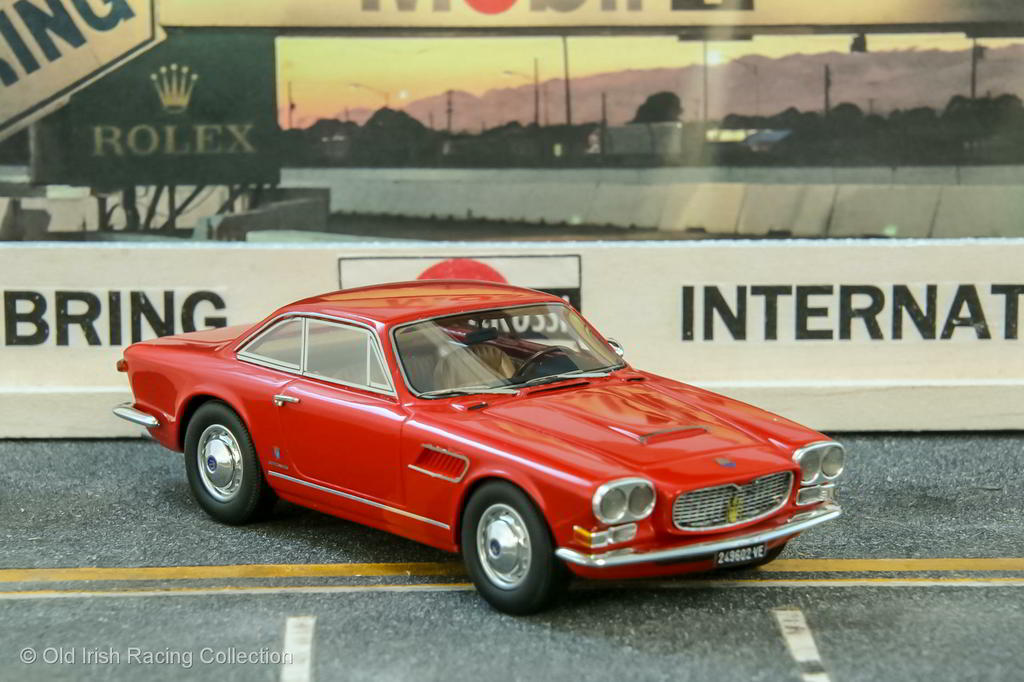 |
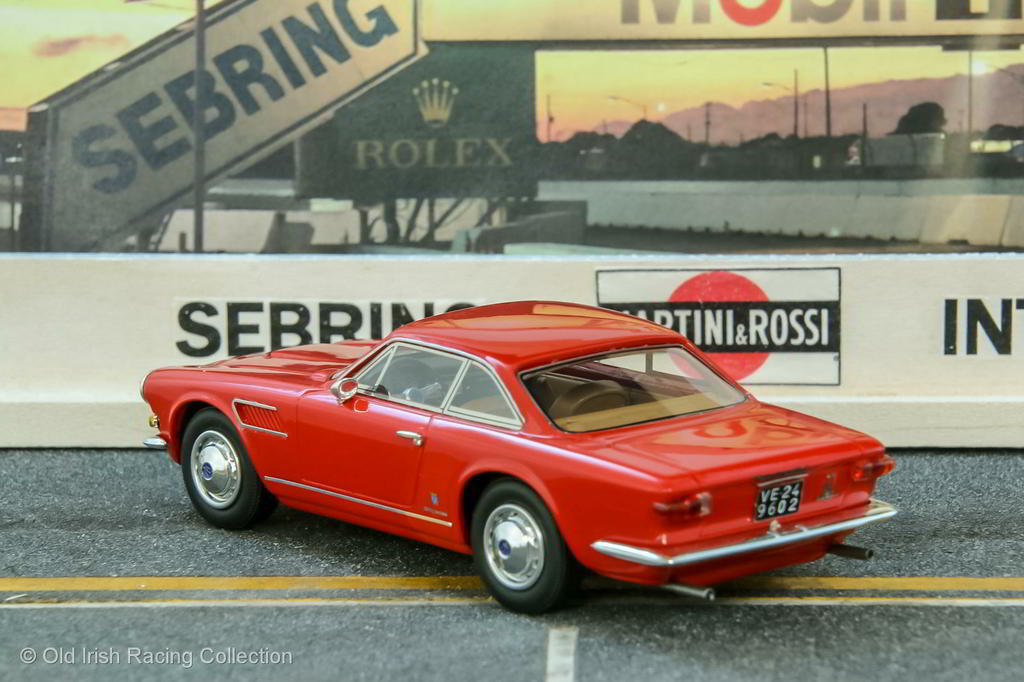 |
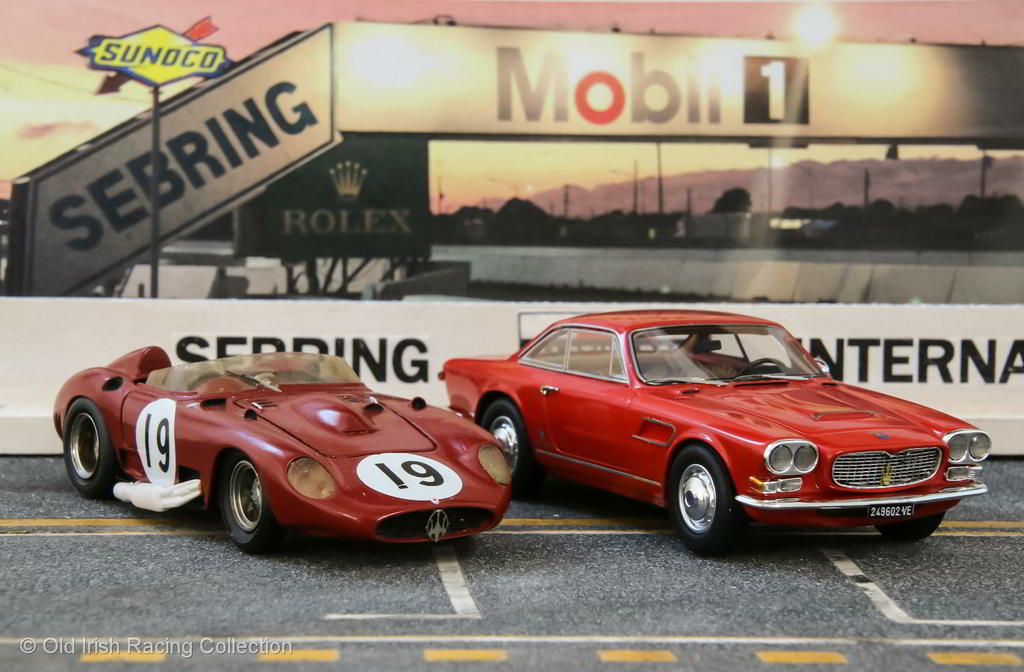 |
 |
1960 Maserati Sebring II: Maserati introduced the Sebring, a 2+2 coupe, as a sportier version of the 3500 in 1962 and production lasted until 1968. Aimed at the American GT market, the car was named for the Maserati victory at Sebring in 1957. The Sebring used the 3.5L fuel injected in-line six-cylinder engine drive train and suspension used in the 3500, but with revised coupe coachwork. In the first two years, 348 of what has become known as the Series I Sebring were built.
Model by MATRIX 1/43 |
1960 Maserati Sebring II: In 1964, the Series II Sebring was introduced. The engine was updated to produce 232 HP. The body was also updated with redesigned tail and headlamps, slimmer bumpers and the car sat on larger Pirelli tires. The Series II had further engine upgrades to 3.7L & 4.0L versions in 1965. This car is an early Series II and has the 3.5L in-line six which could move the car to 145 MPH. It is one of the 247 Series II Sebrings made.
Model by MATRIX 1/43 |
|
1961 Maserati 3500 GTi: The 3500 GTi was the first fuel-injected Italian production car. It was put into producton in 1961 alongside the 3500 GT introduced in 1957.Powered by a 3.5L in-line six producing 235 bhp, a A 5-speed ZF S5-17 gearbox was standard, as were four wheel disc brakes and 16" wheels. The 3500 GTi was good for 145 mph. 2000 examples of the 3500 GT and GTi were made between 1958-1964, with most bodies coming from Touring.
Model by da GRANI & PARTNERS 1/43 |
 |
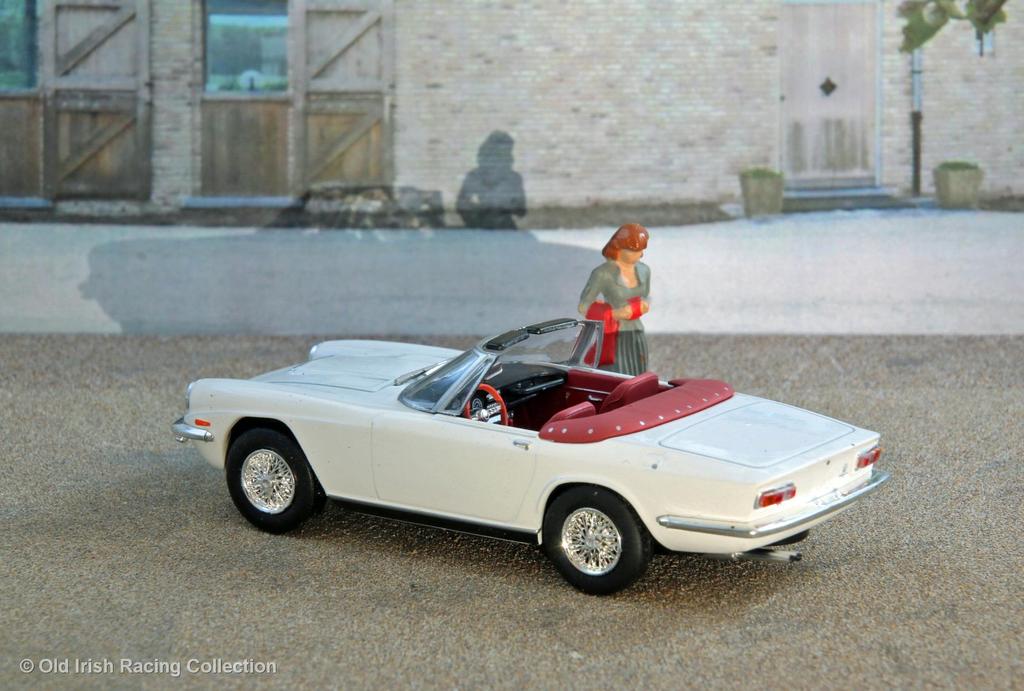 |
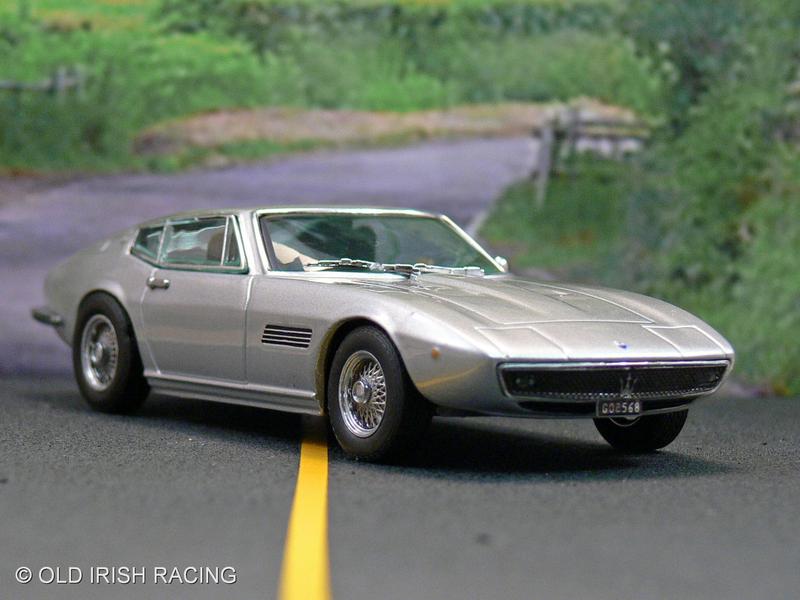 |
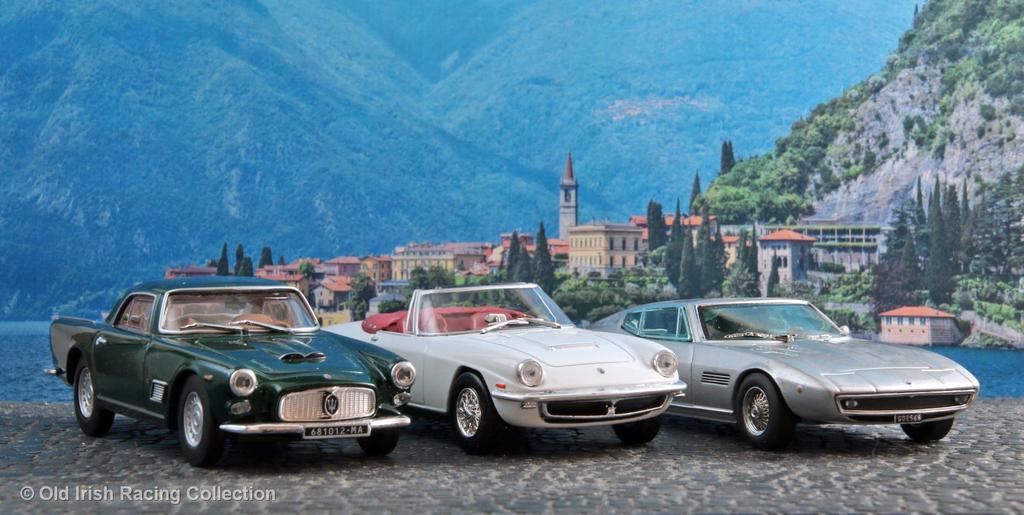 |
1964 Maserati Mistral Spyder: Introduced in 1963 and replaced the 3500GT and was itself replaced in 1970 by the Ghibli. The Frua designed car was available with wither a 3.7L or 4.0L straight-six engine with fuel injection. The car could reach at top speed of 145 mph. Over the life of its production, Maserati made 828 coupes and 125 spyders. The Mistral started the Maserati tradition of naming its models after famous winds.
Model by WHITE BOX 1/43 |
|
1971 Maserati Ghibli SS: The Ghibli famous for its low, shark-shaped nose body, was designed by Giorgetto Giugiaro. The car is powered by a 4.7L, 330 hp V8 engine, with a 0-60 mph acceleration time of 6.8 seconds and a top speed of 154 mph. The slightly more powerful Ghibli SS (335 hp) was released in 1970. The Ghibli outsold its two biggest rivals, the Ferrari Daytona and the Lamborghini Miura.
Model by IXO 1/43 |
 |
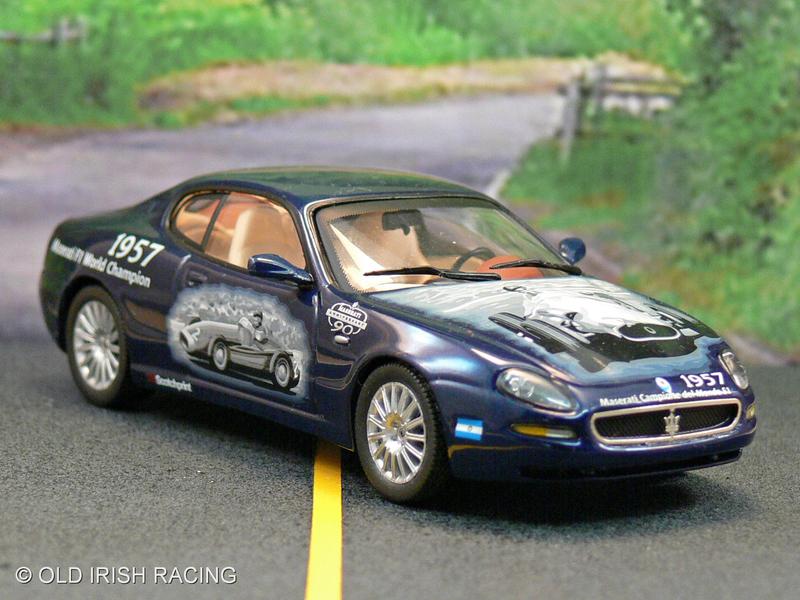 |
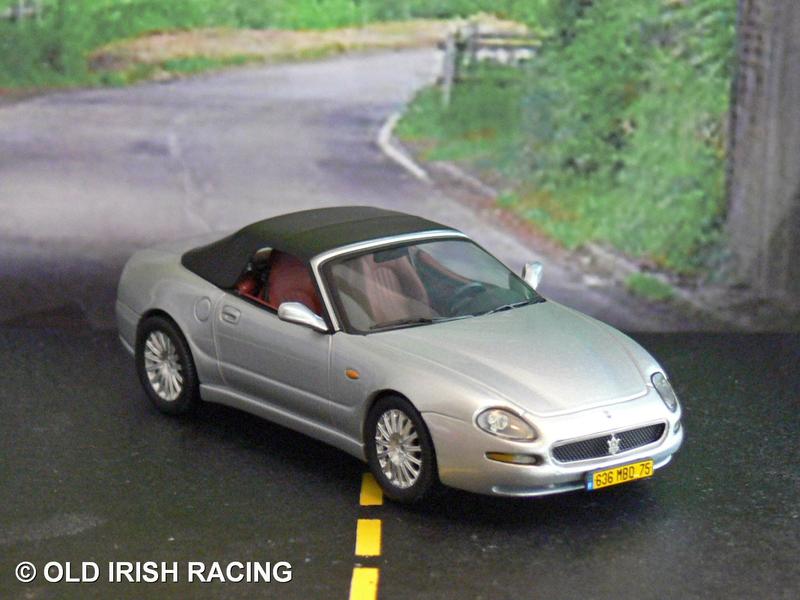 |
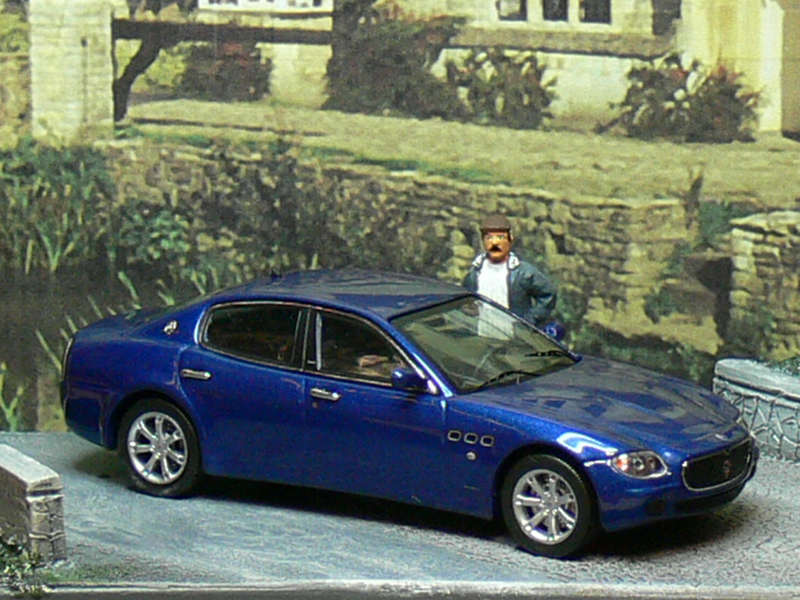 |
1971 Maserati Indy: Named to celebrate Maserati's two victories at the Indy 500, the Indy was sold alongside the Ghibli as a 2+2 alternative GT car. The Indy was offered only with a 4.2 Litre V8. For the 1970 model years, the Indy started sporting a 290 bhp 4.7 L V8 engine, adding the Ghibli SS's 4.9 Litre V8 to the range, albeit downrated to 320 bhp compared to the Ghibli's 335 bhp. From 1973 to 1974, both the 4.2 and 4.7 Litre engines were supplanted by the 4.9.
Model by IXO 1/43 |
2004 Maserati Coupe Cambriocorsa: "The Coupe Cambriocorsa was introduced in 2002 and produced until 2007. Cambriocorsa means ""racing shift"" and together with its 390 hp 4.2 liter V8, designed and built by Ferrari, a driver can launch the car from a 0 to 60 mph in 4.8 seconds. This car features a tribute to Fangio and his F1 World Championship in 1957.
Model by IXO 1/43 |
2004 Maerati Spyder Cambiocorsa: The Cambiocorsa (Italian, meaning "race change")is an electrohydraulic manual transmission that uses a Formula One-type gearbox with hydraulic operation and electronic management operated by F1-style paddles behind the steering wheel, similar to the system used in Ferrari vehicles.
Model by IXO 1/43 |
2007 Maserati Quattroporte Sport GT: With a Ferrari-designed and built 4.2 liter V8 engine to further exploit the exceptional handling and balance of this sensational Pininfarinia styled sedan. Producing 400 bhp, the V8 engine pushes the Quattroporte Sport GT to a top speed of 170 mph and 0-60 mph acceleration time of just 5.6 seconds. A six-speed dual mode ZF transmission with paddle shifters, 20"" wheels, Brembo brakes and an interior trimmed in rich leather with carbon fiber accents, who wouldn't want to own one?
Model by IXO 1/43 |
To continue to another section of the Old Irish Racing Collection, select one of the following:
THE SIGNATURE PROJECT & RACING DIORAMAS
RACING SUPPORT VEHICLES, TRANSPORTERS & OTHER TRUCKS
JAGUAR RACING CARS:
1950's
1960 - 1979
1980 - 1989
1990's - Present
JAGUAR AT LE MANS
JAGUAR AUTOMOBILIA
JAGUAR PRODUCTION CARS:
PRE-WAR to 1959
1960 to 1968
1969-1987
1988 - Present
JAGUAR CONCEPT CARS
EACH JAGUAR MODEL FROM 1935 IN PRODUCTION ORDER
FERRARI RACING CARS:
1949 - 1959
1960 - 1969
1970 - 1979
1980 - Current
FERRARI FORMULA ONE
FERRARI PRODUCTION CARS
PORSCHE RACING & PRODUCTION CARS:
PORSCHE RACING 1950's & 60's
PORSCHE RACING 1970's
PORSCHE RACING 1980's
PORSCHE RACING 1990 - Current
PORSCHE PRODUCTION CARS
FORMULA 1, GRAND PRIX, INDY:
1900 - 1959
1960 - 1969
1970 - 1979
1980 - PRESENT
THE TRIPLE CROWN OF ENDURANCE RACES:
THE 24 HOURS of LE MANS 1923-2019
THE 12 Hours of SEBRING WINNERS
THE 24 HOURS of DAYTONA WINNERS
GREAT AUTOMOTIVE MAKES:
ABARTH
ALFA ROMEO
ASTON MARTIN
AUDI
AUSTIN HEALEY & HEALEY
BMW
CHAPARRAL
CHEVROLET POWER
DATSUN/NISSAN
FORD POWER - GT40's, MUSTANGS, MIRAGE & MORE
LANCIA
LOLA SPORTS CARS
LOTUS
McLAREN
MASERATI
MERCEDES BENZ
MG CARS
SHELBY'S COBRAS, DAYTONAS, FORD GT40's & MUSTANGS
TOYOTA
TRIUMPH
RACING, RALLYE, SPORTS, GT & CLASSIC CARS
RACING SPORTS, GT & PROTOTYPE CARS 1945 to 1959
RACING SPORTS, GT & PROTOTYPE CARS 1960 to 1969
RACING SPORTS, GT & PROTOTYPE CARS 1970 to 1979
RACING SPORTS, GT & PROTOTYPE CARS 1980 to Current
LAND SPEED RECORD CARS
SPORTS. GT & TOURING CARS
VETERAN, CLASSIC & SPECIAL INTEREST CARS
DRIVER TRIBUTES:
THE OLD IRISH RACING HALL OF FAME
JUAN MANUEL FANGIO TRIBUTE
STIRLING MOSS TRIBUTE
DAN GURNEY TRIBUTE
JIM CLARK TRIBUTE
WORLD DRIVER & CONSTRUCTORS CHAMPIONS 1950 - 1985
GREAT RACING TEAMS:
BRUMOS RACING TEAM
CUNNINGHAM RACING TEAM
ECURIE ECOSSE
GROUP 44, Inc.
OLD IRISH AIR FORCE:
HISTORIC AIRCRAFT
For copies of images, questions or comments about the collection to: OLD IRISH RACING
Back to: OLD IRISH RACING MODELS INDEX Home Page
Back to: OLD IRISH RACING Home Page
Legal stuff: Content and images on this website are the property of Old Irish Racing and may not be used without permission. All pages on this website Copyright-Old Irish Racing 2021
This is a private collection, pieces are not for sale!
PLEASE NOTE: From 1968 into the 1990's tobacco companies sponsored many significant race cars. We don't promote tobacco use, rather we stronly discourage it. However, we do promote historical accuracy, Old Irish Racing chooses
to display models in our collection as historically accurate as possible. While seeing a tobacco advert on a car gives me no more desire to go smoke than seeing a car makes me want to go
suck on its exhaust pipe. If tobacco (or alcohol) adverts on race cars offend you, please go look at nice pictures of bunnies and kittens on another site. Thank you!